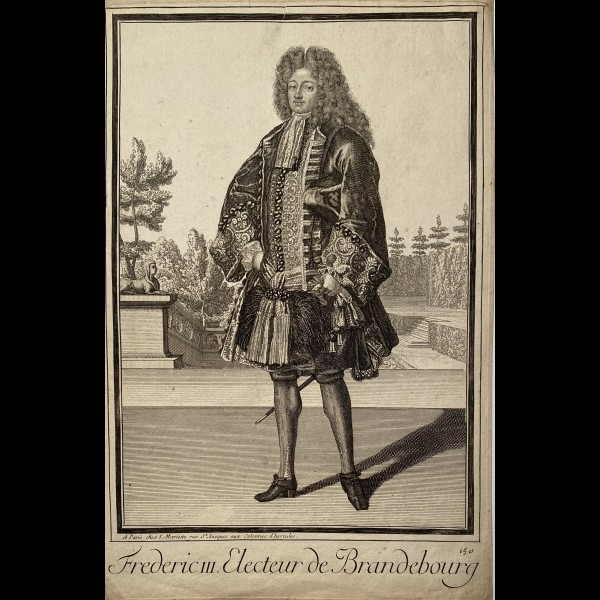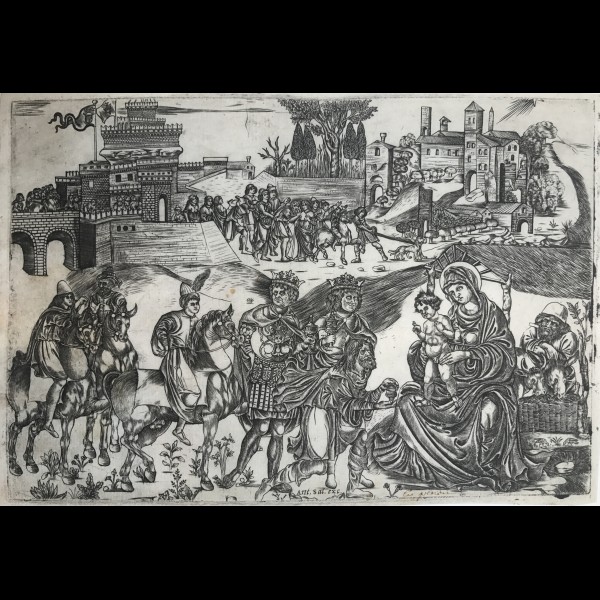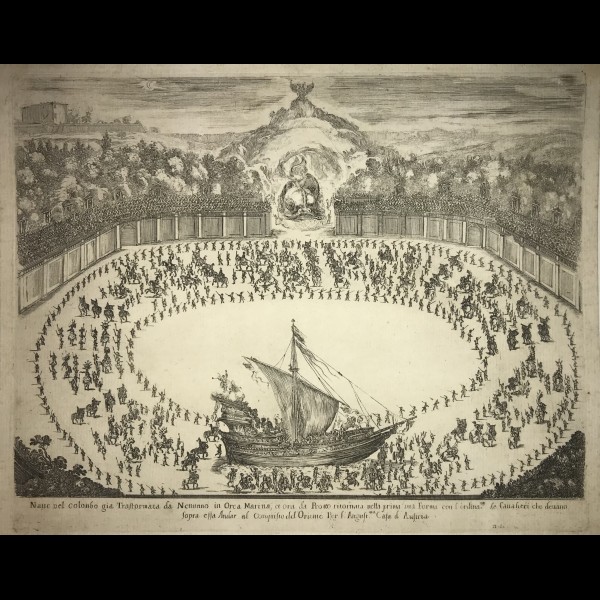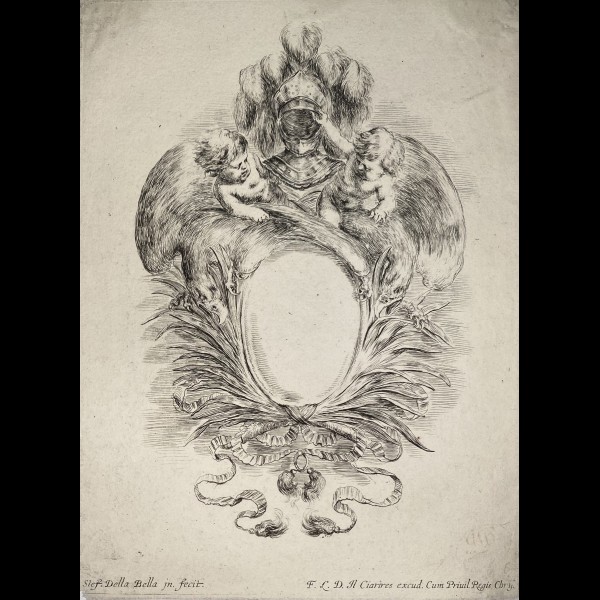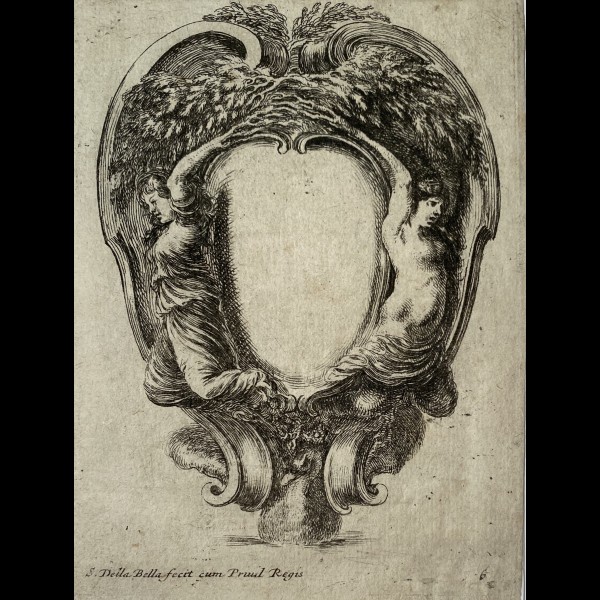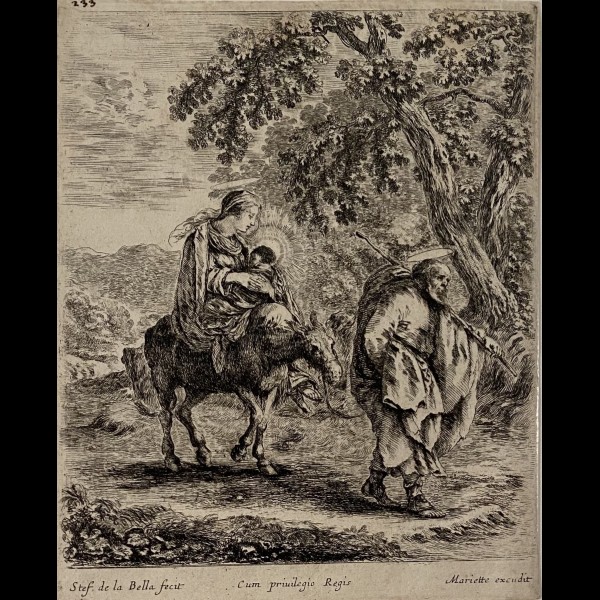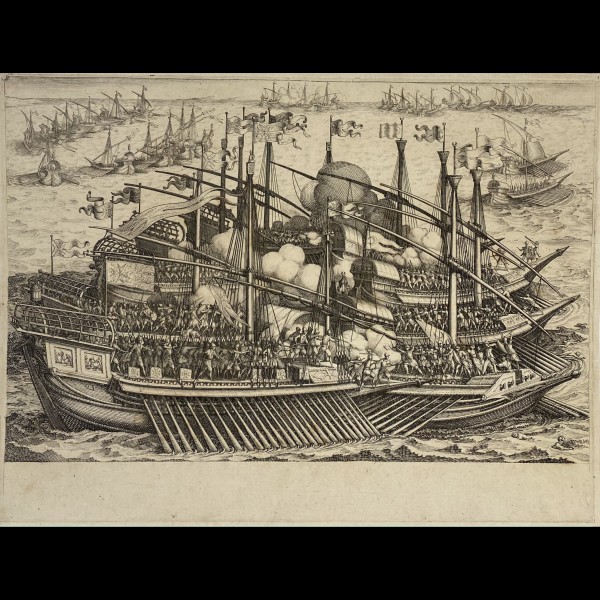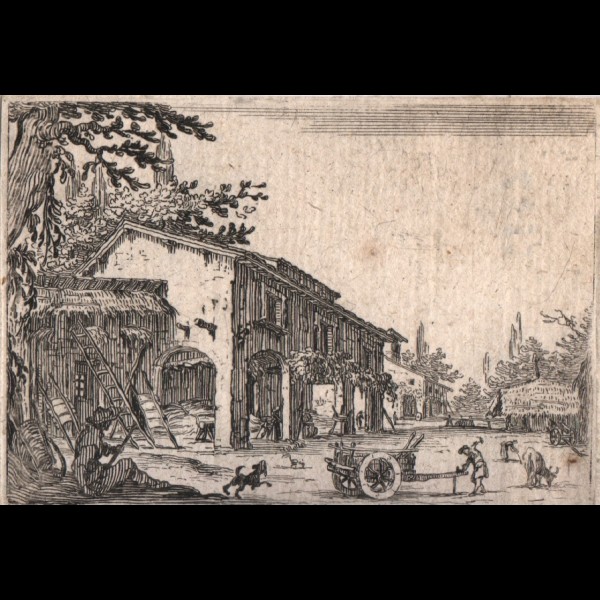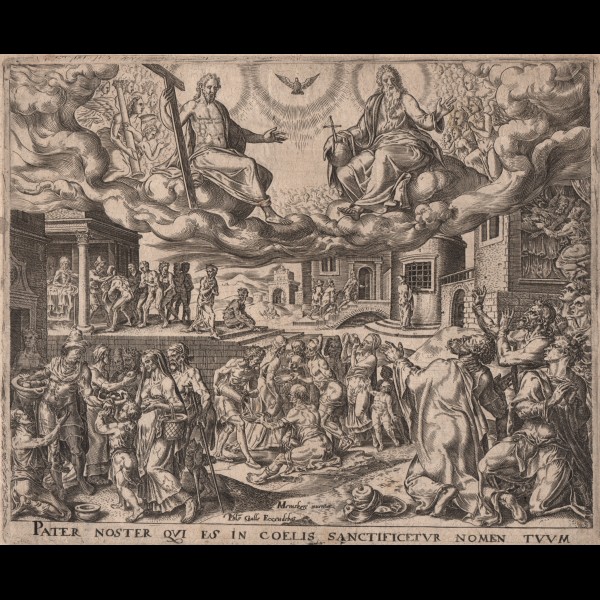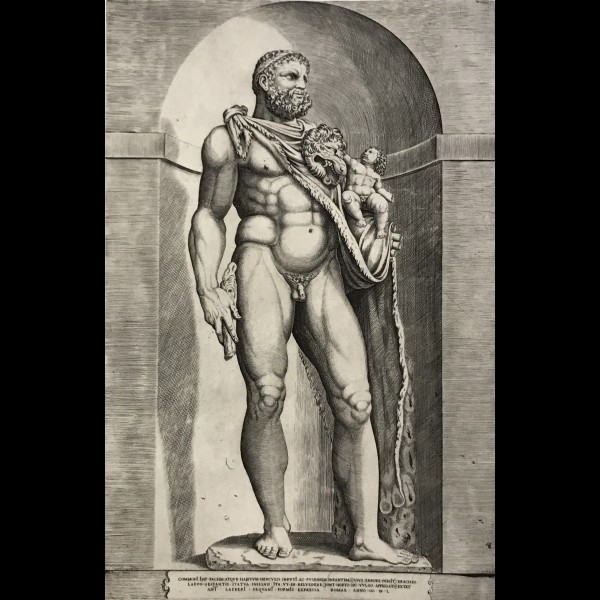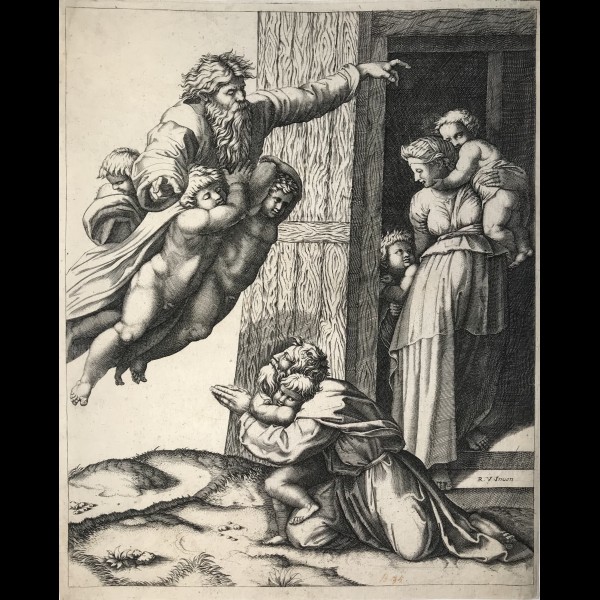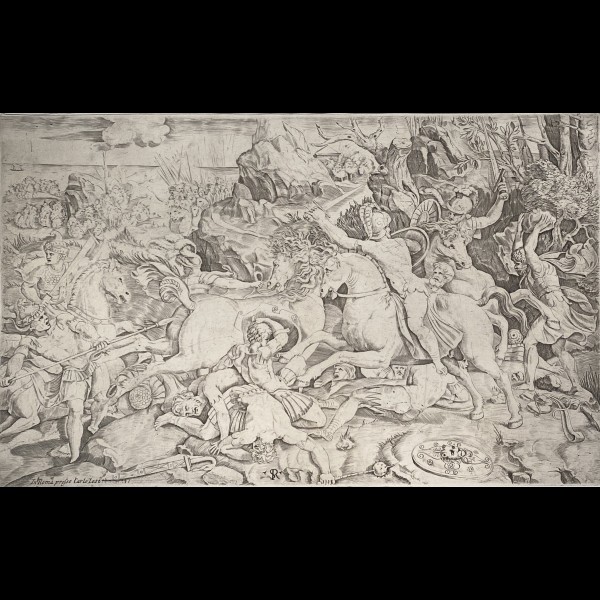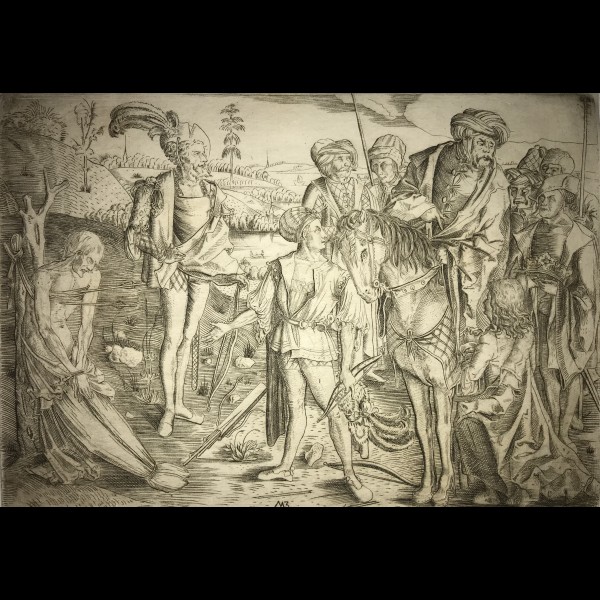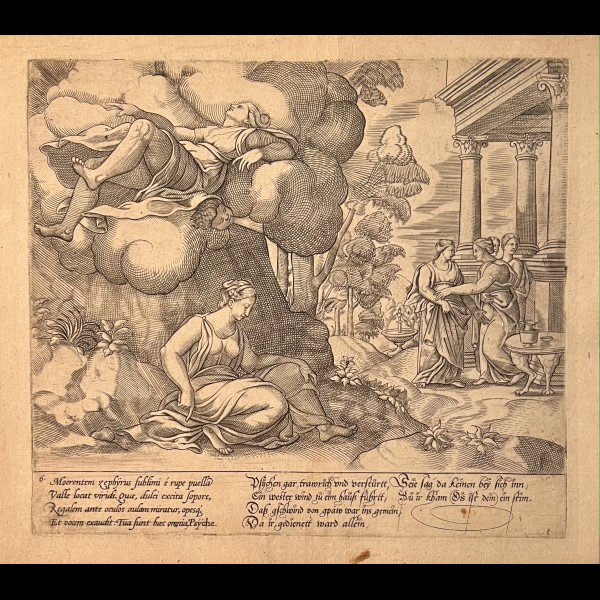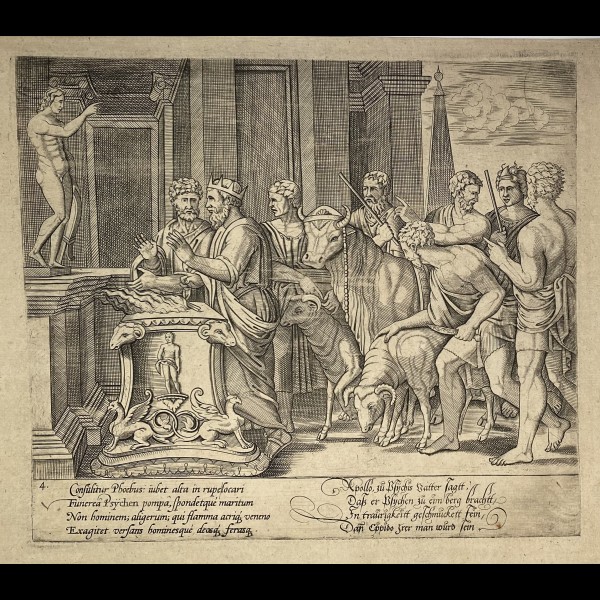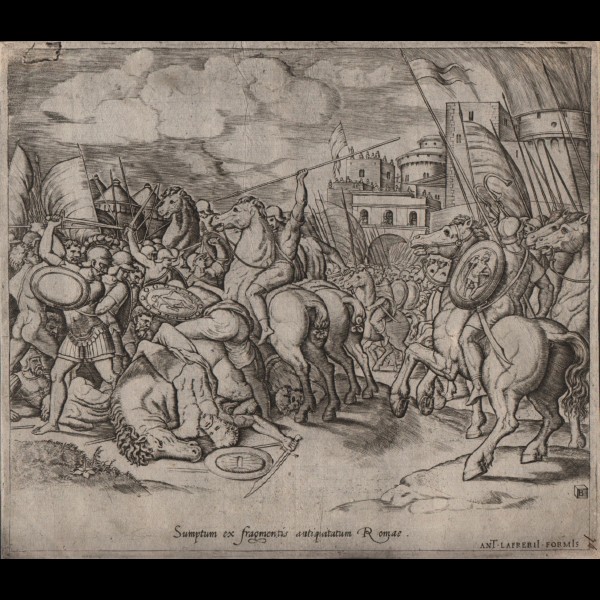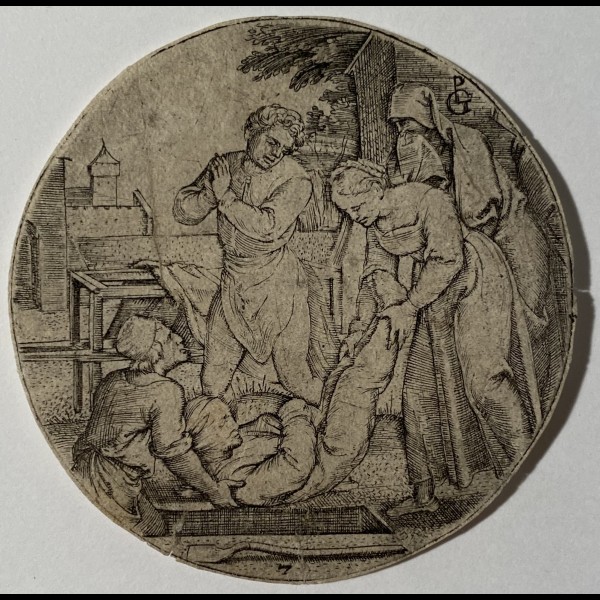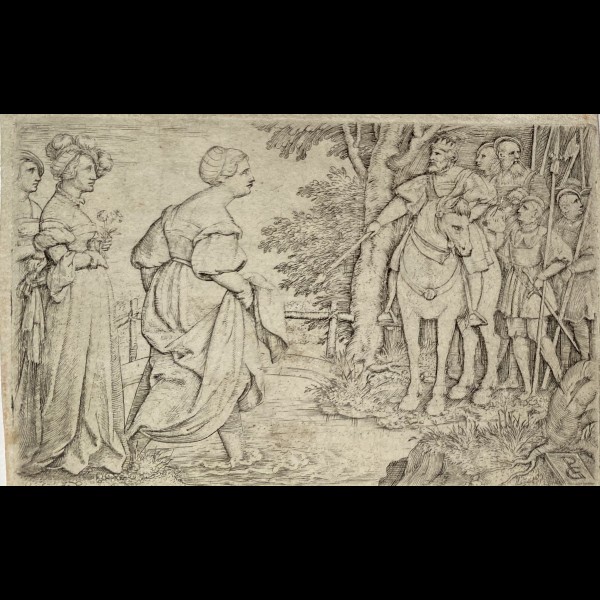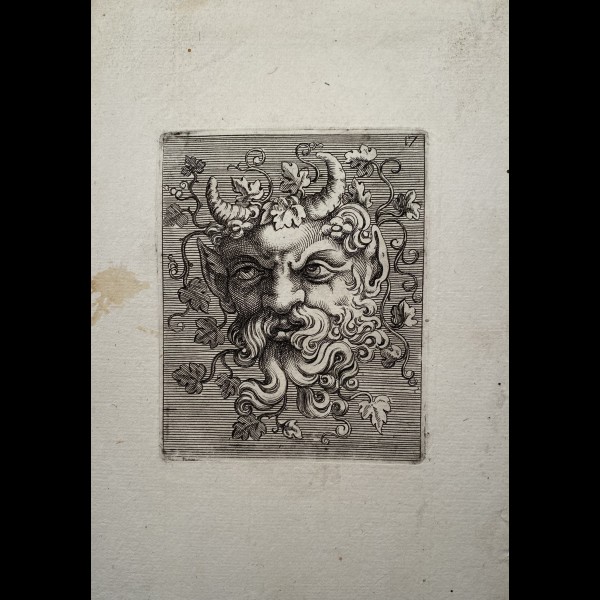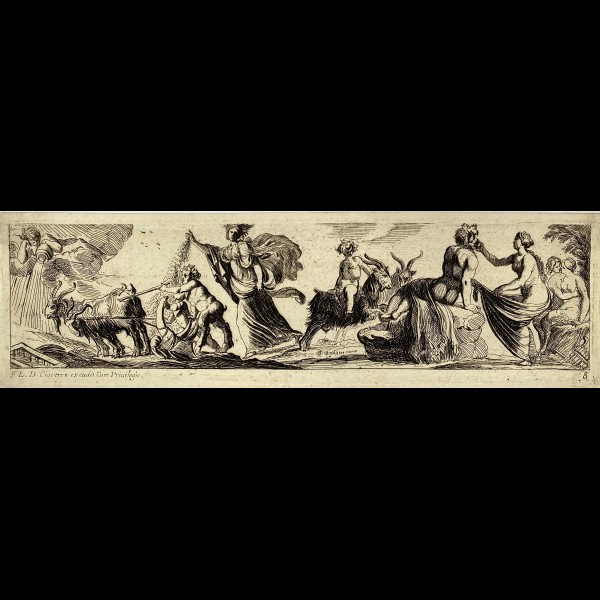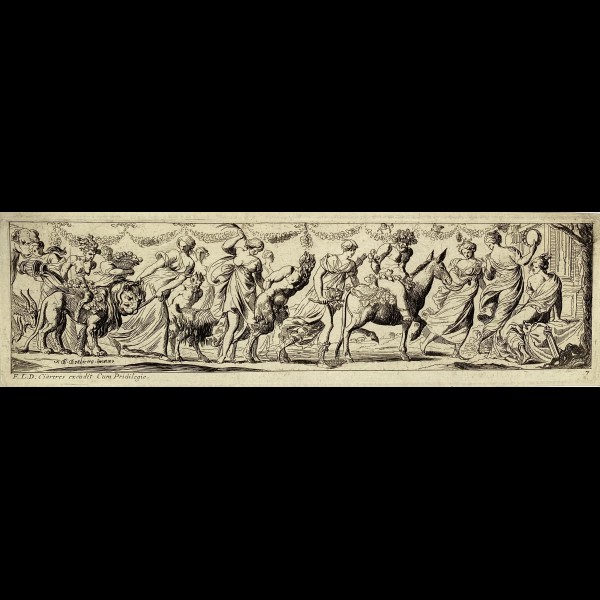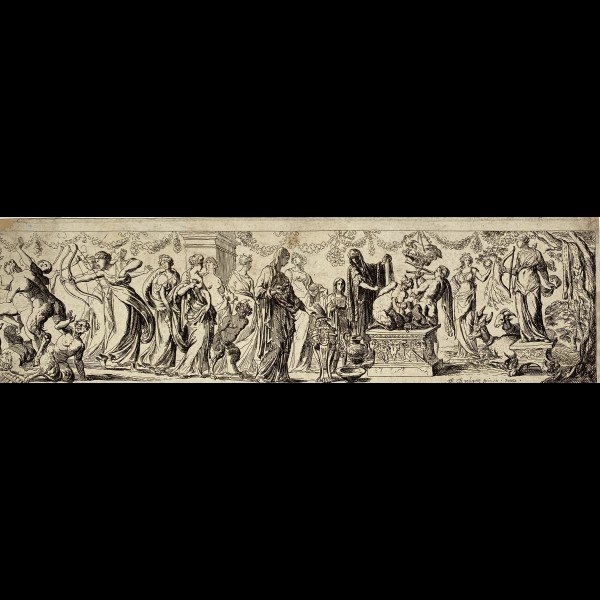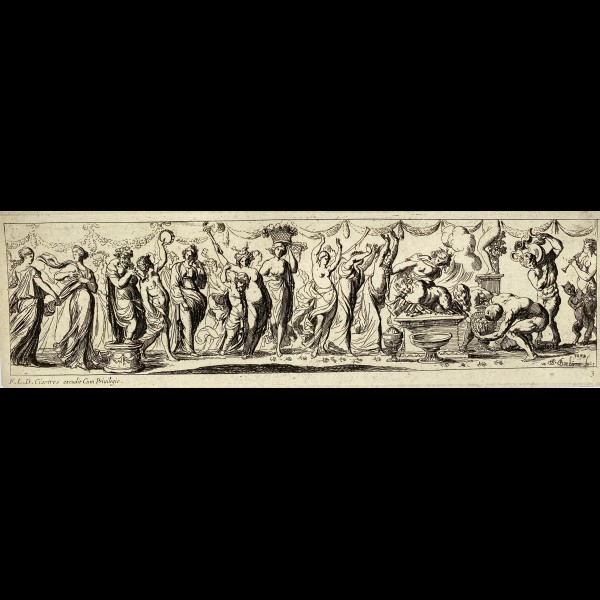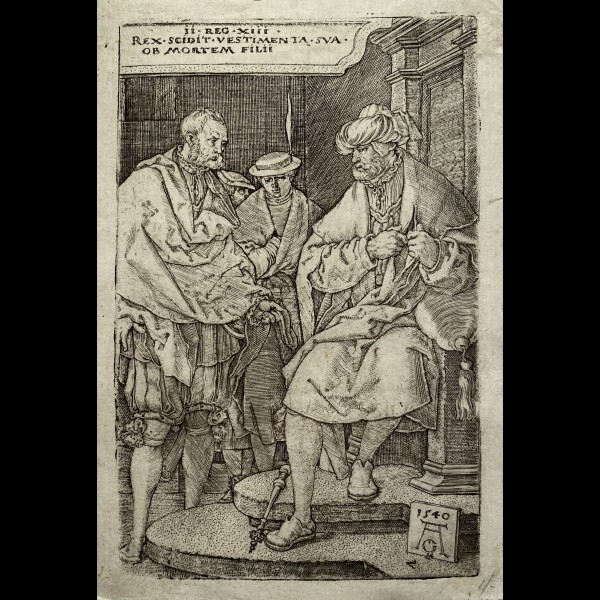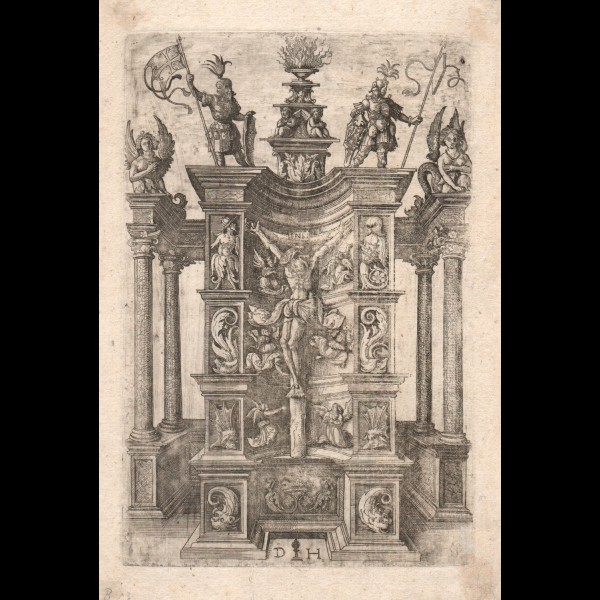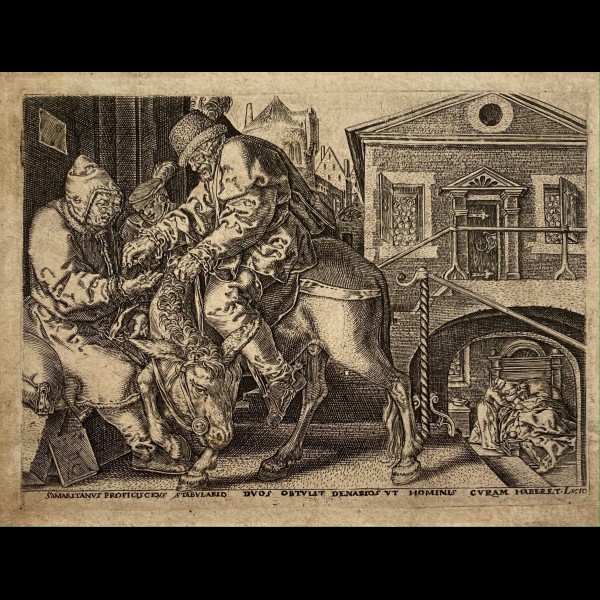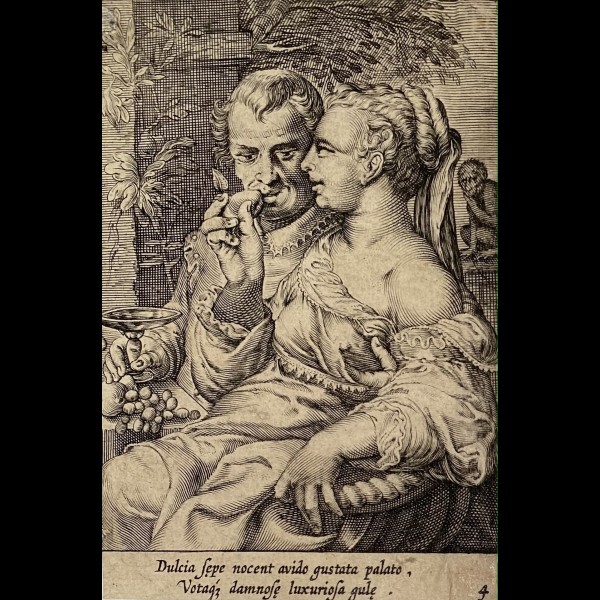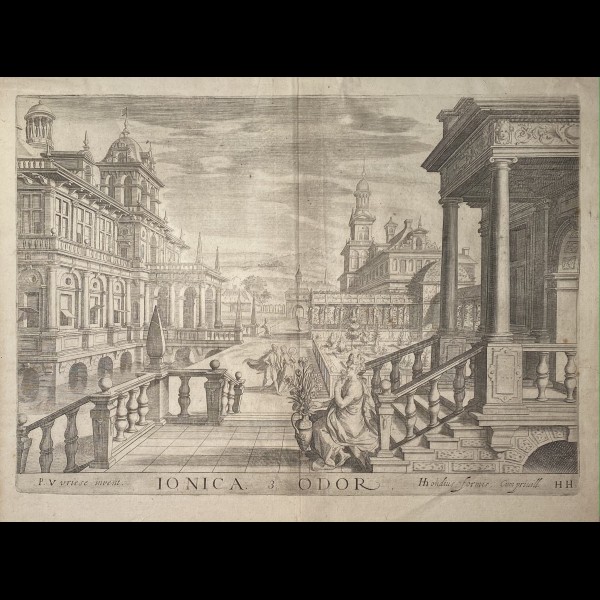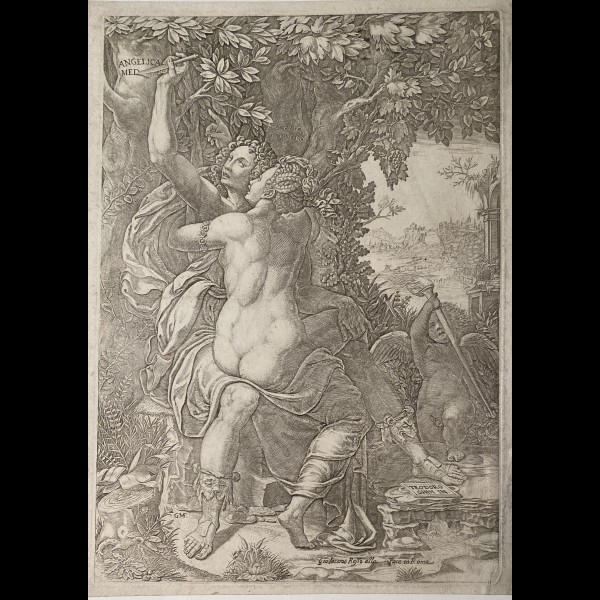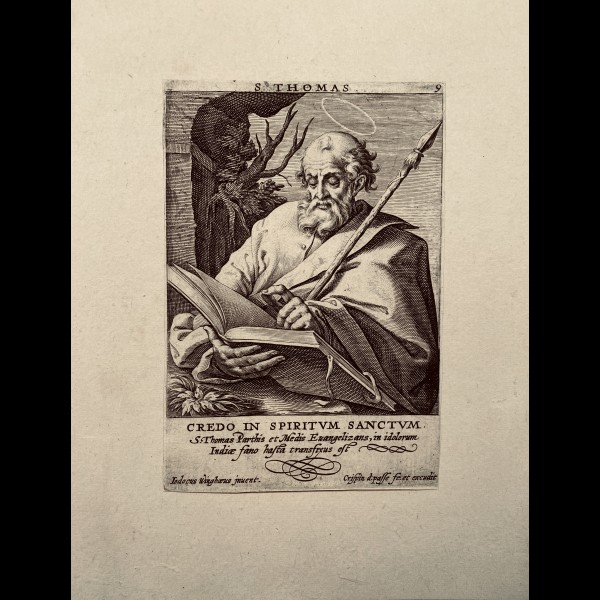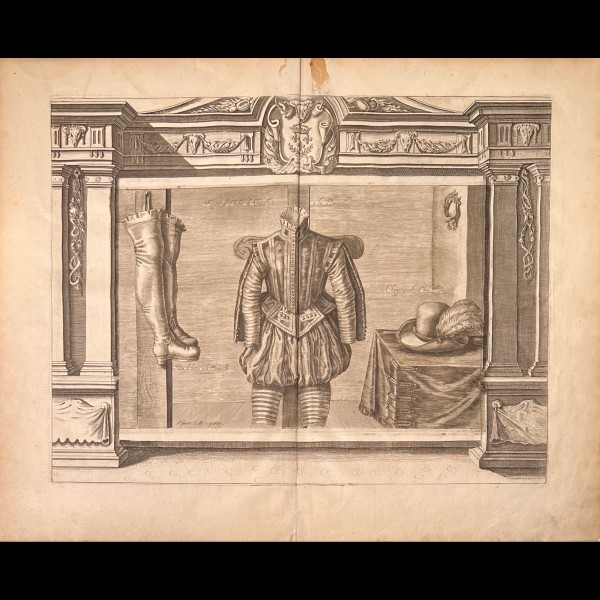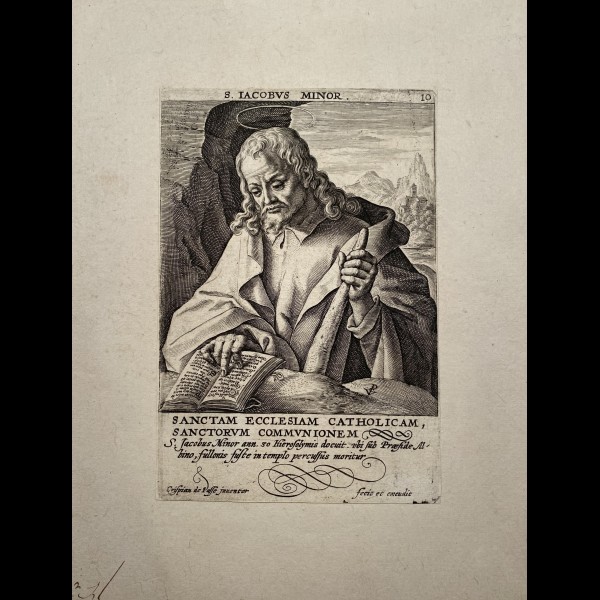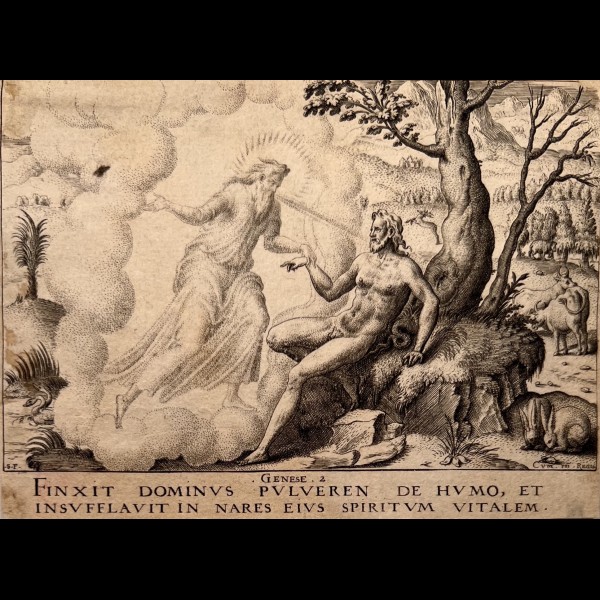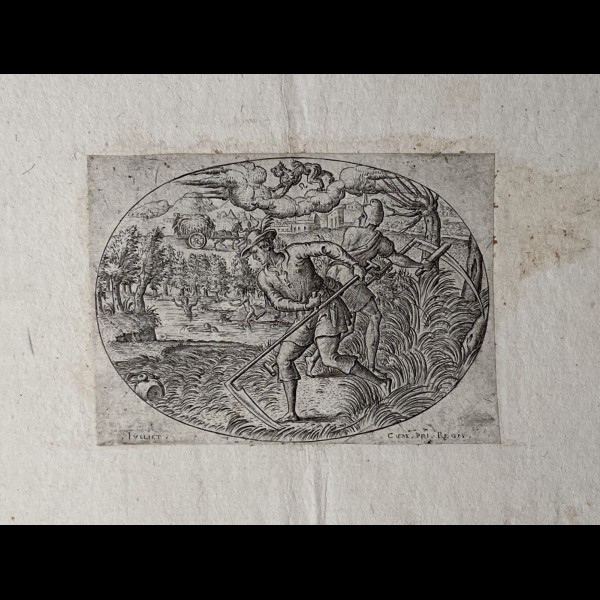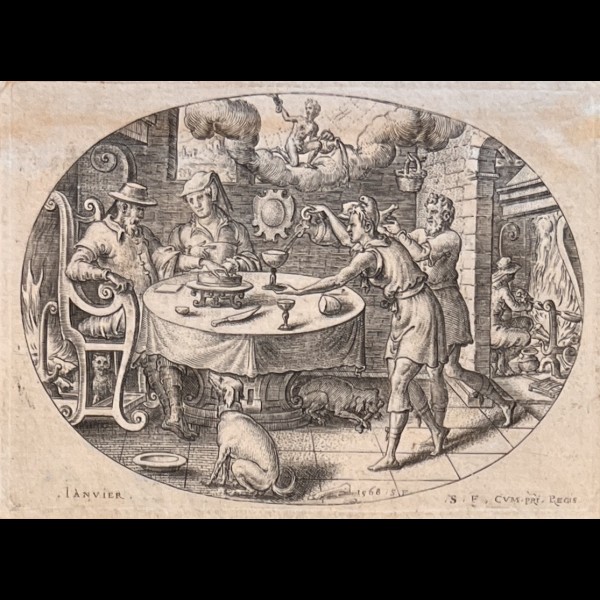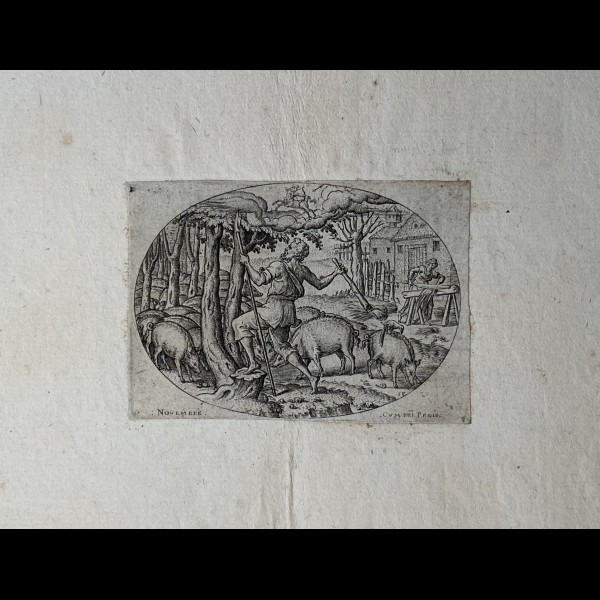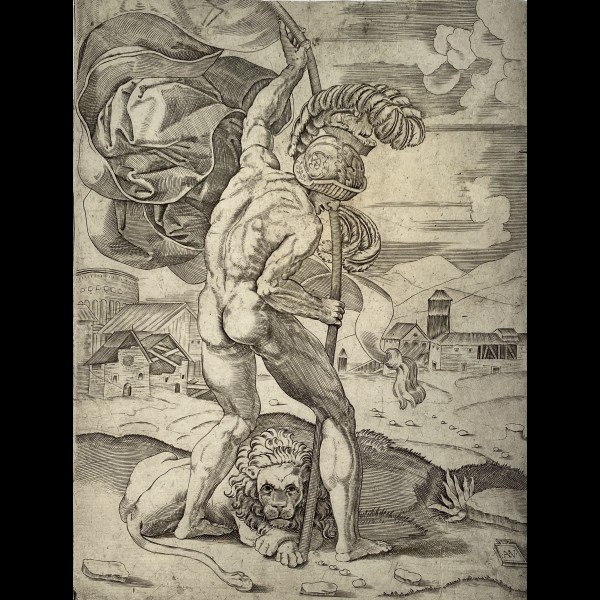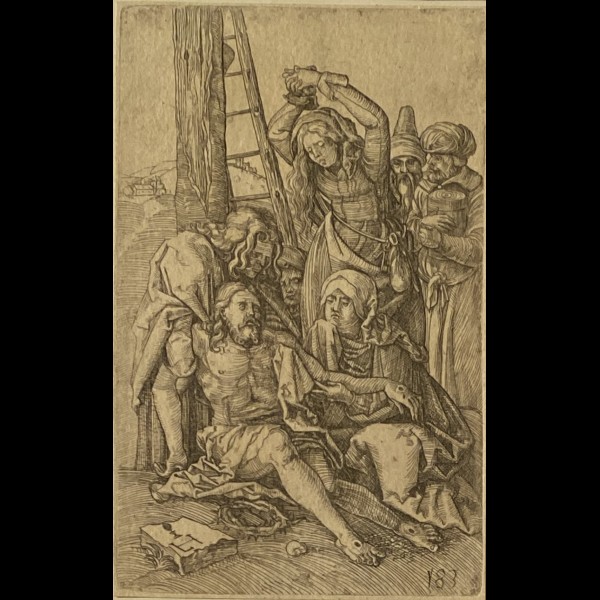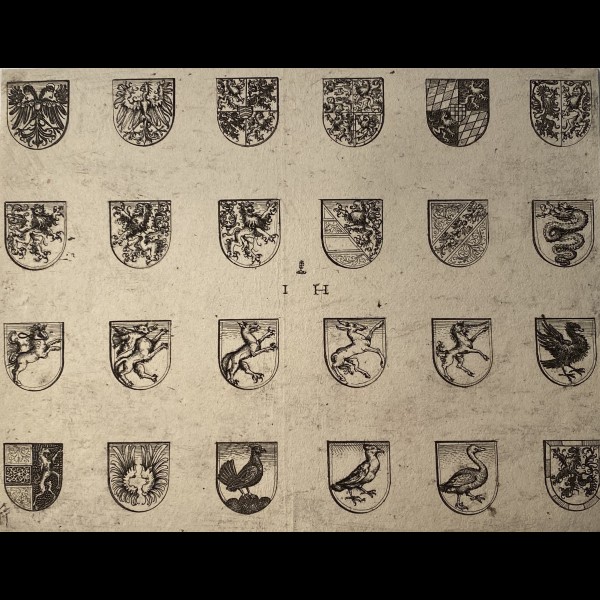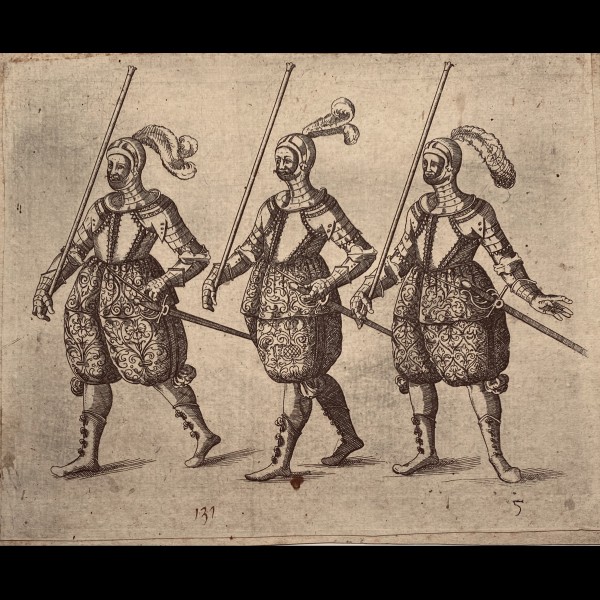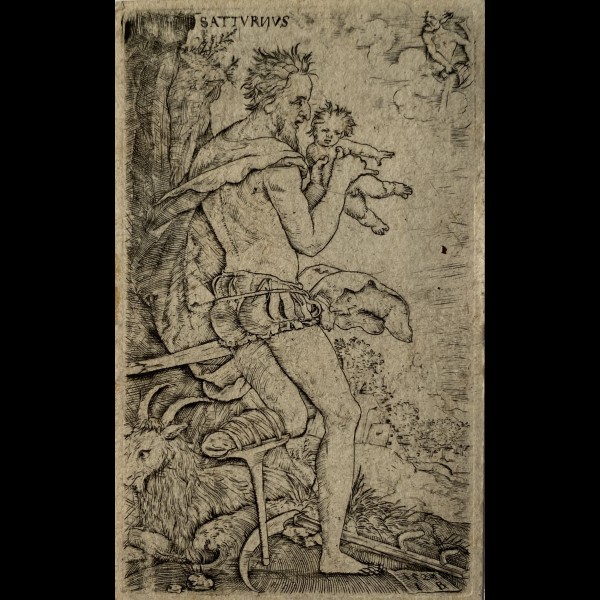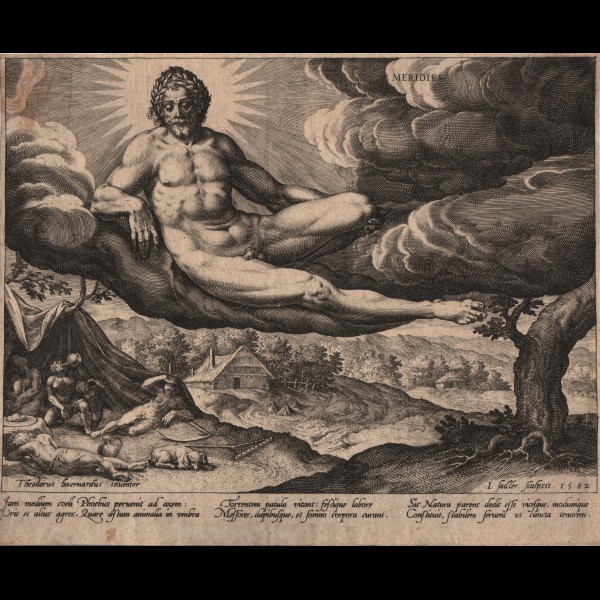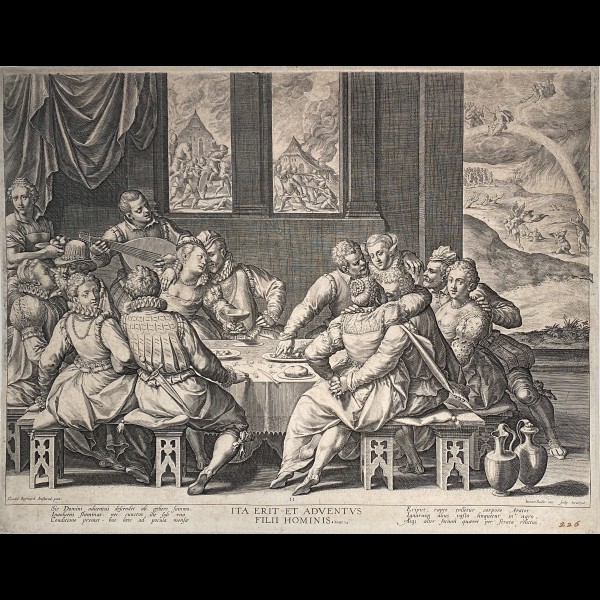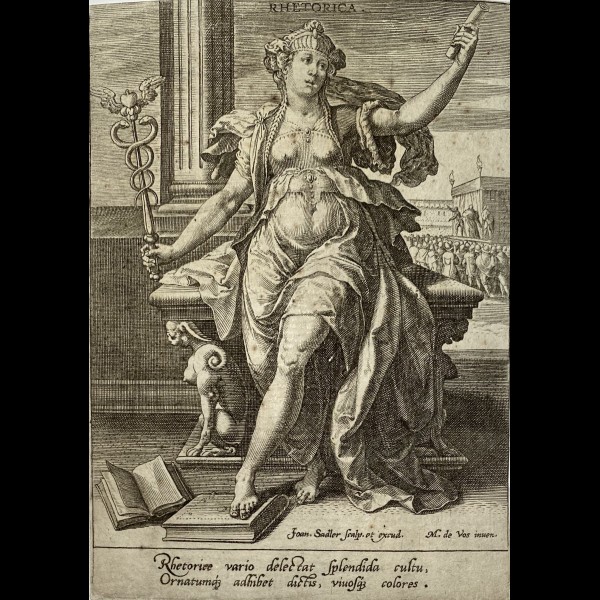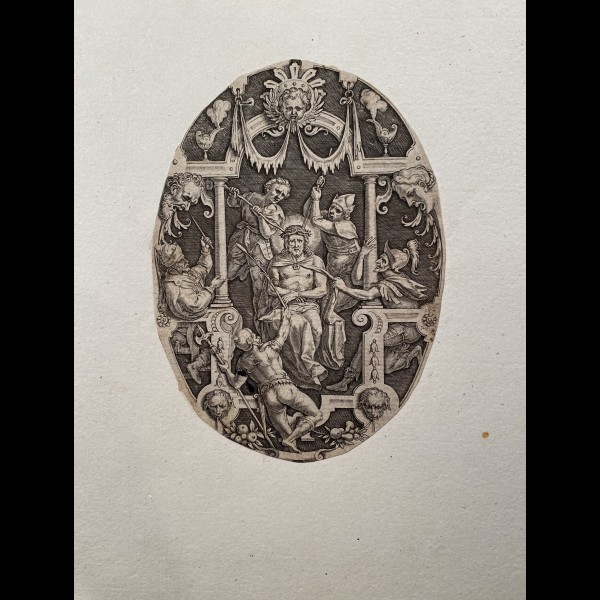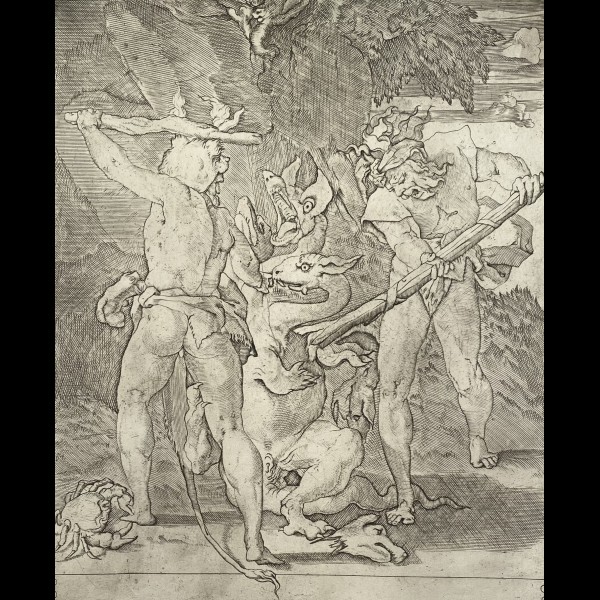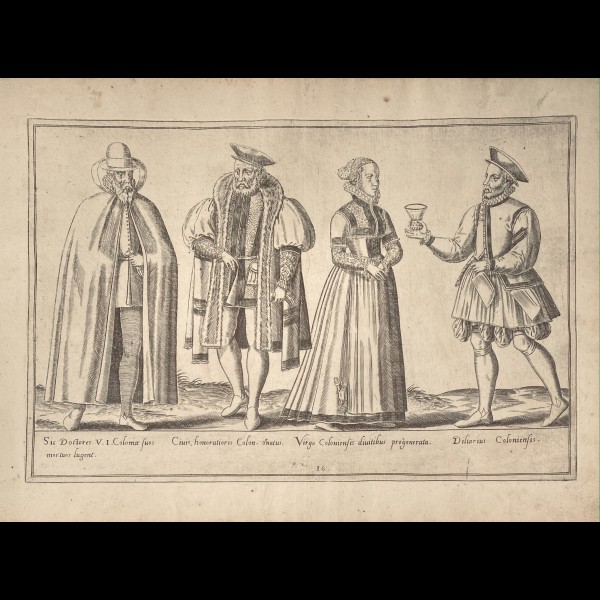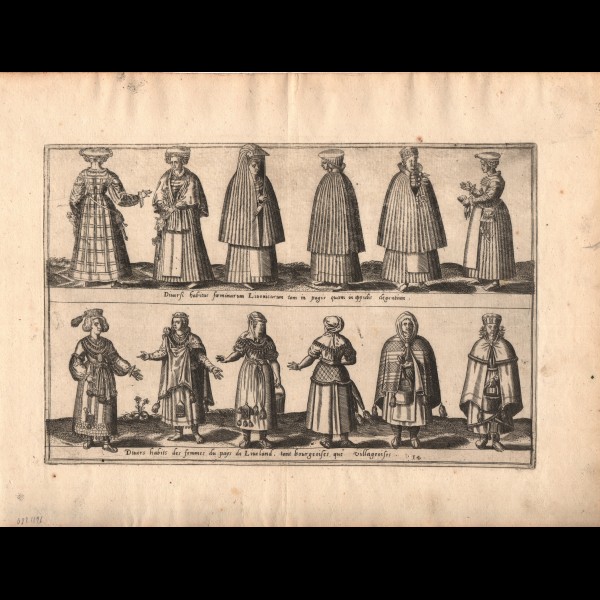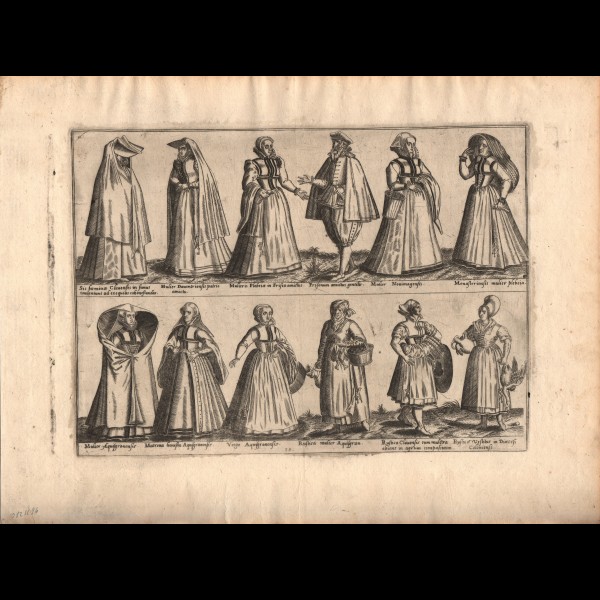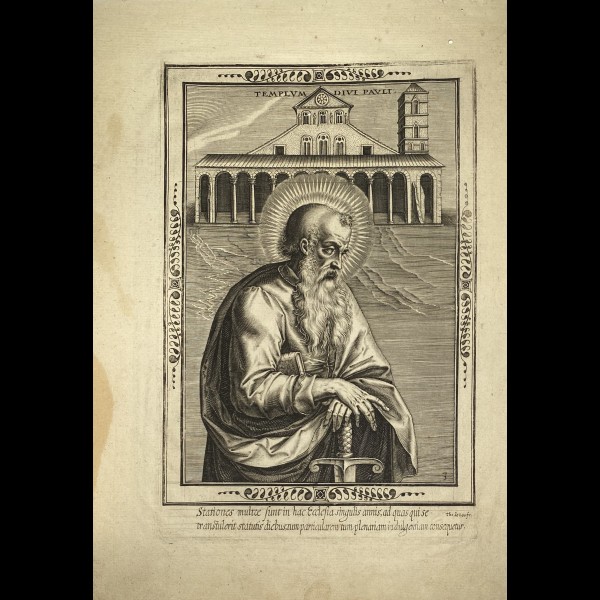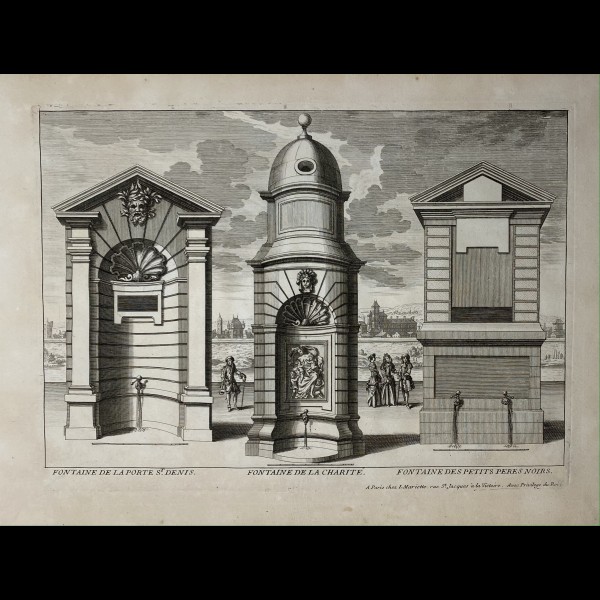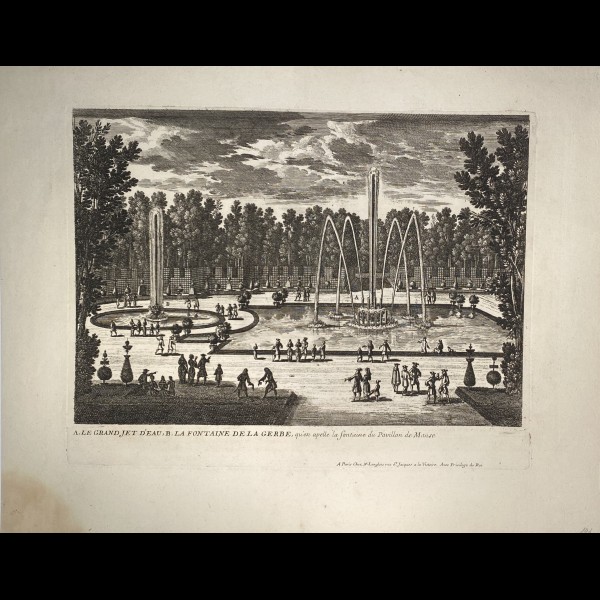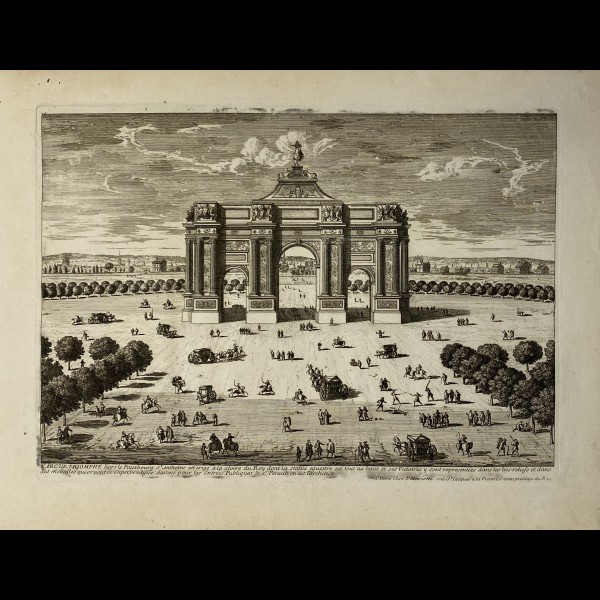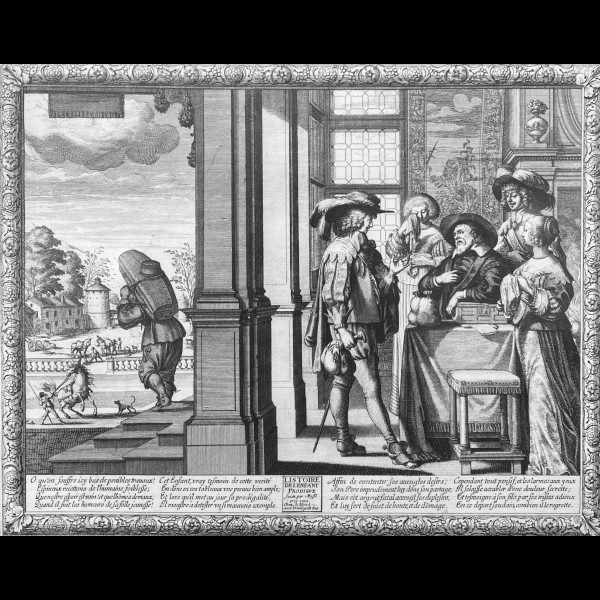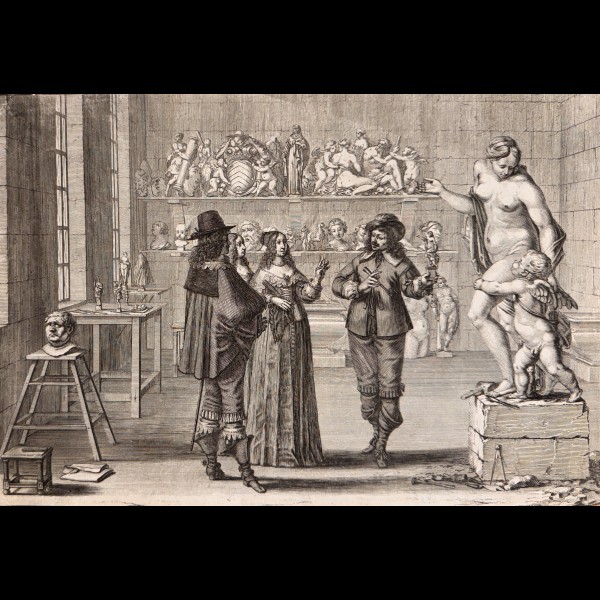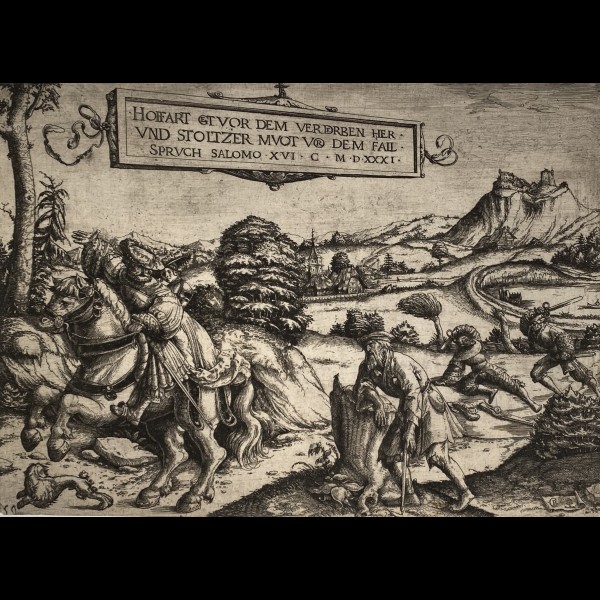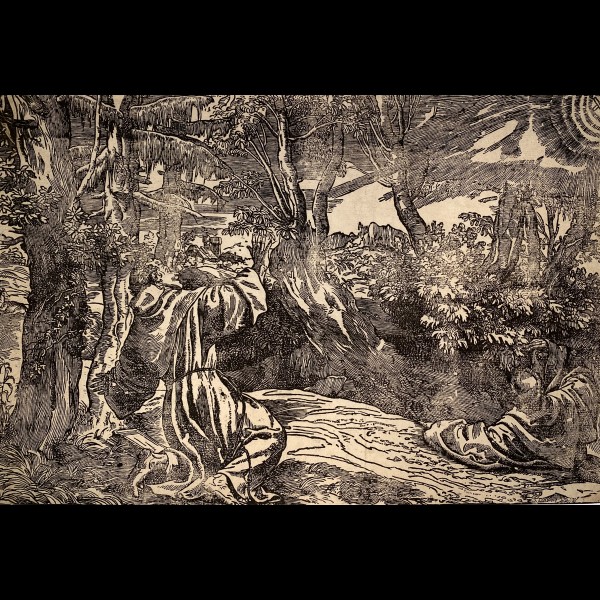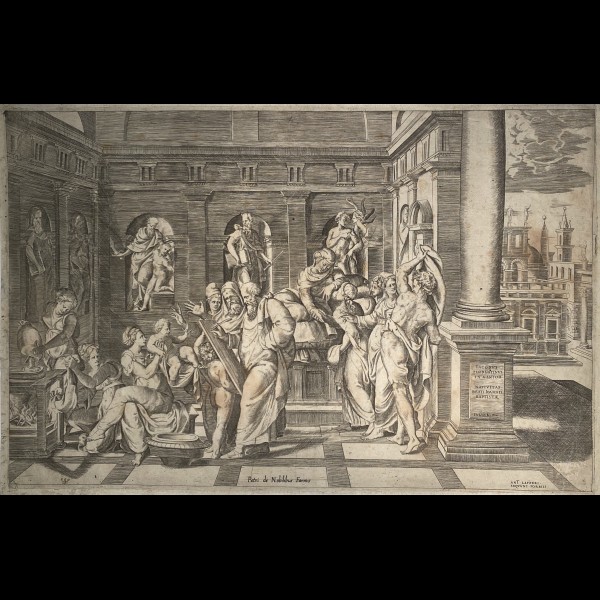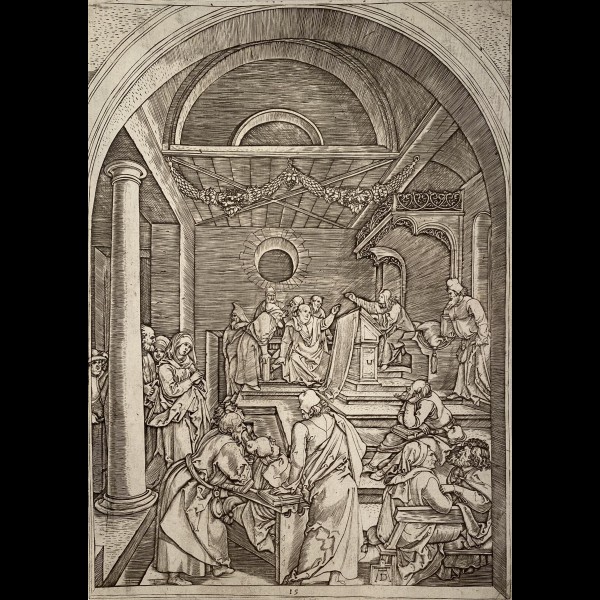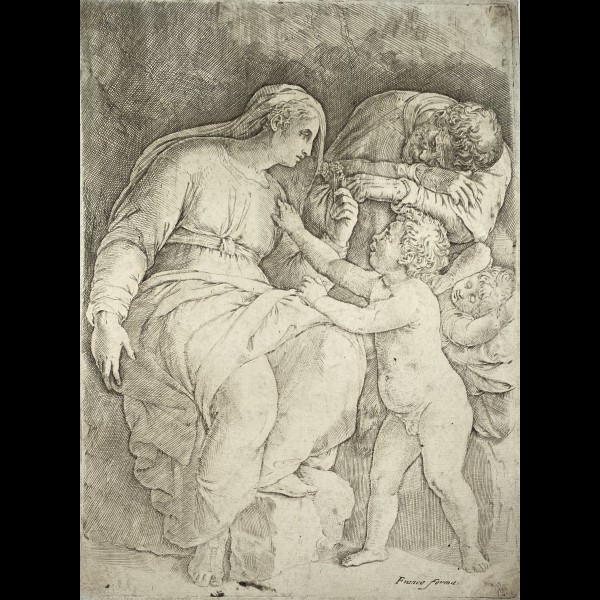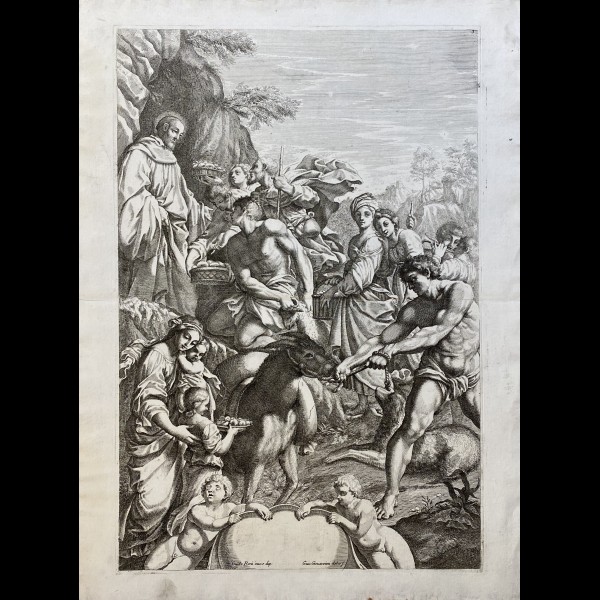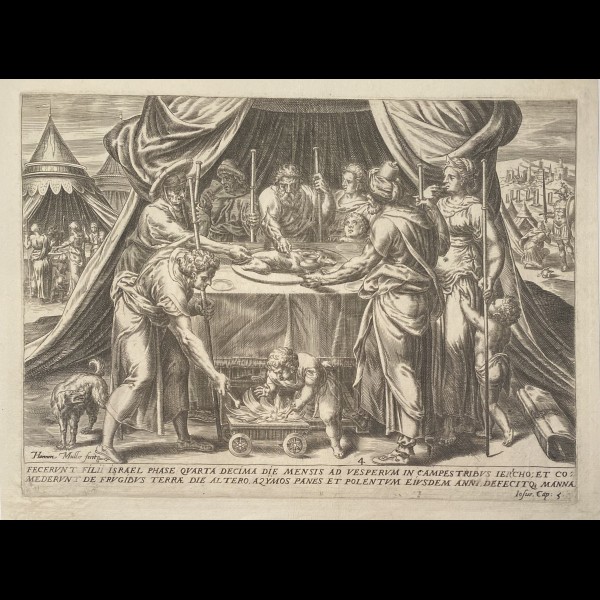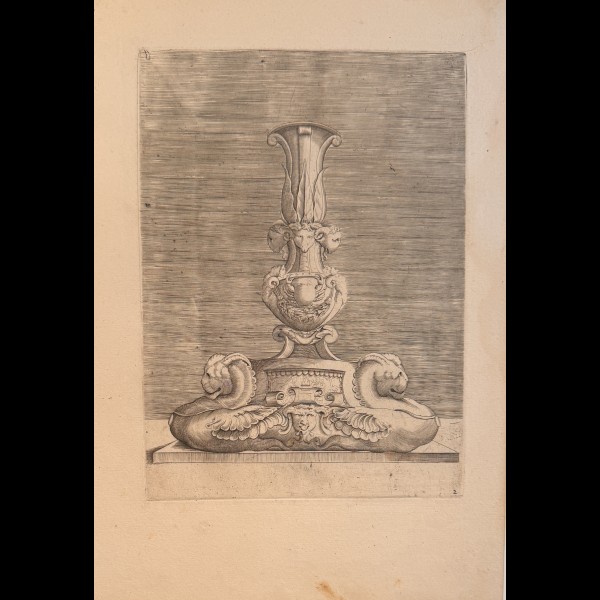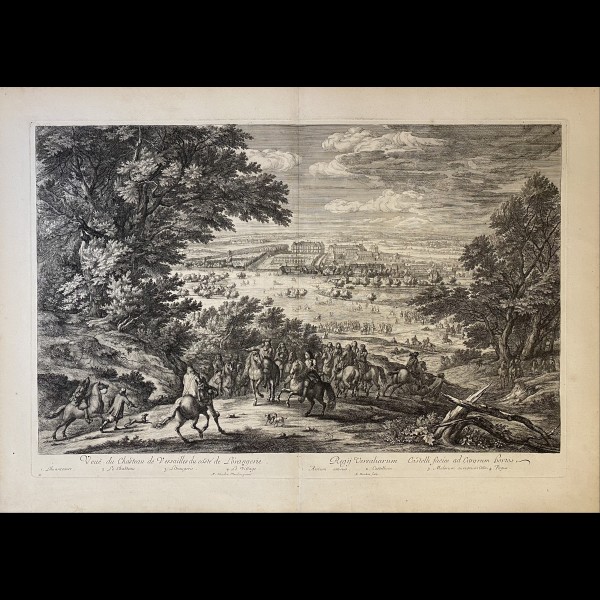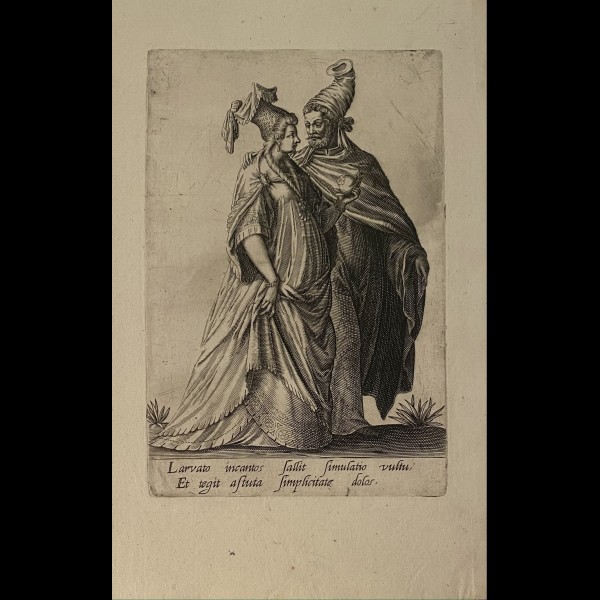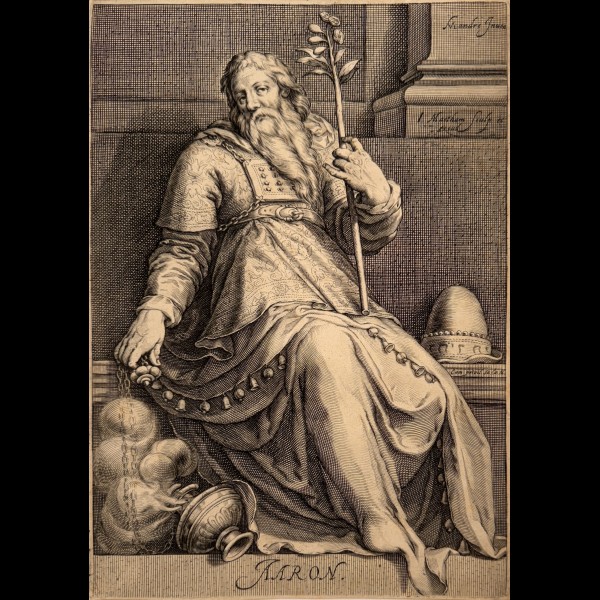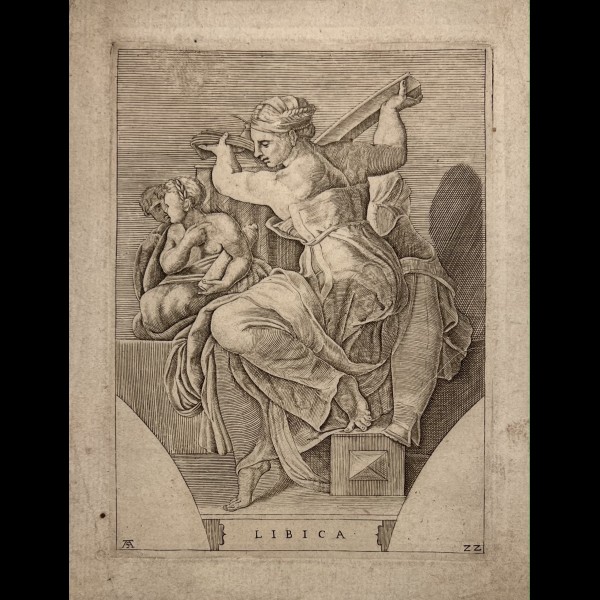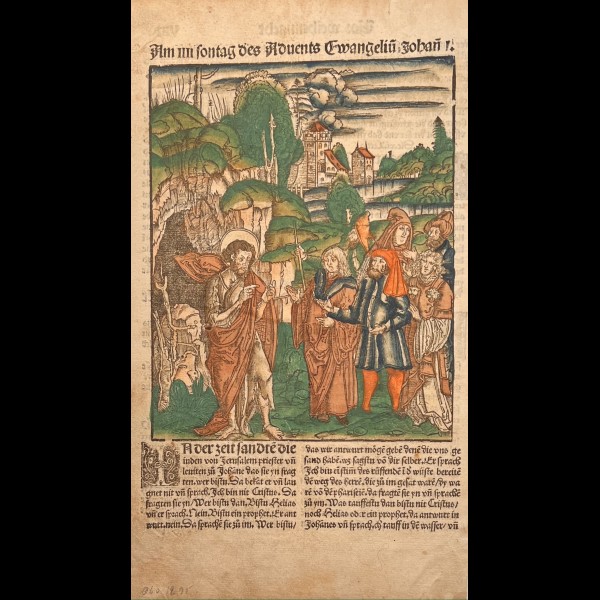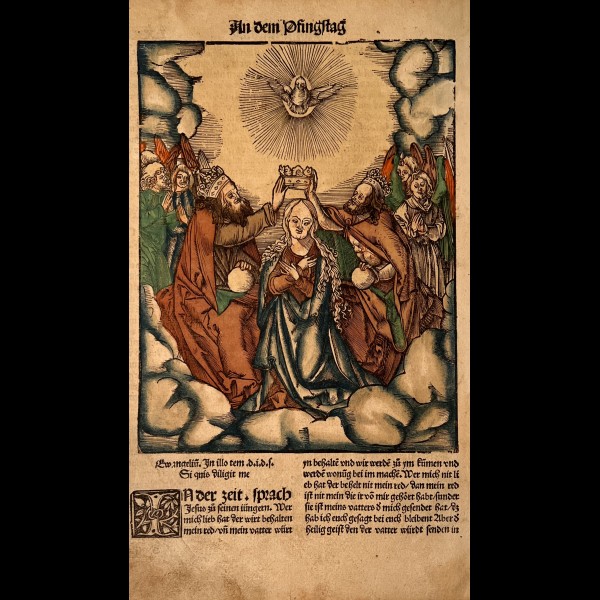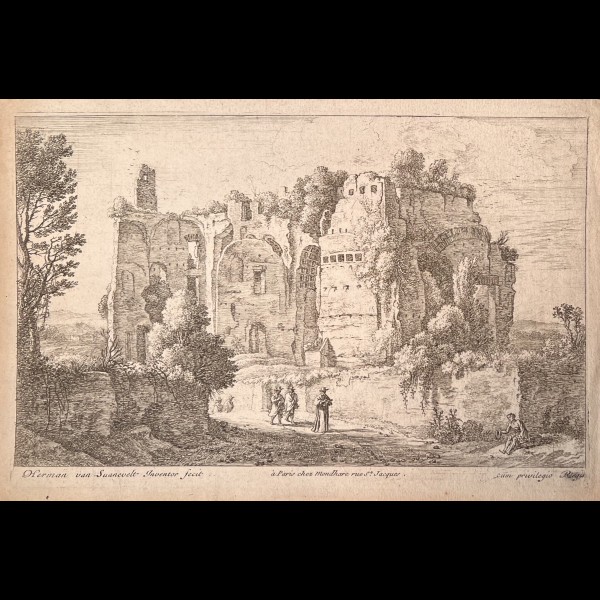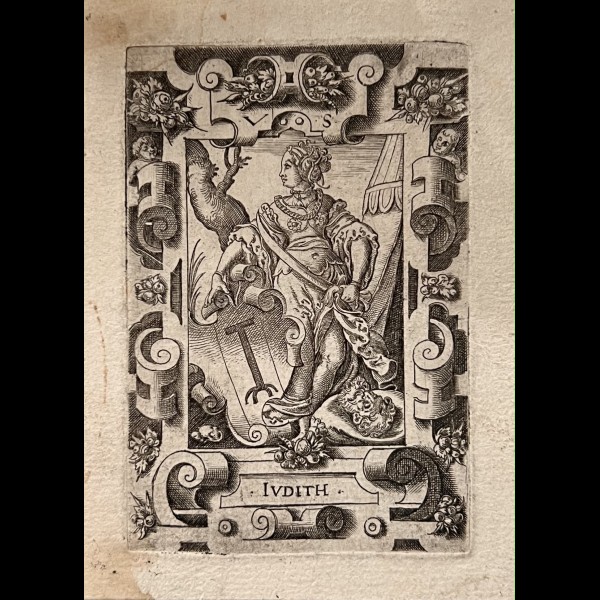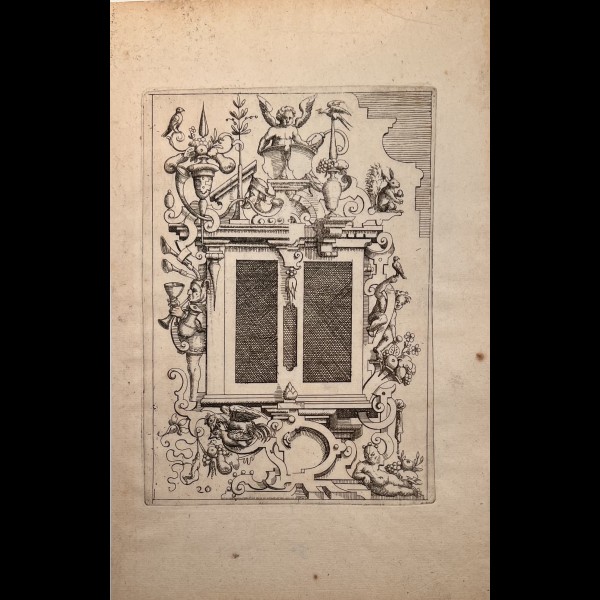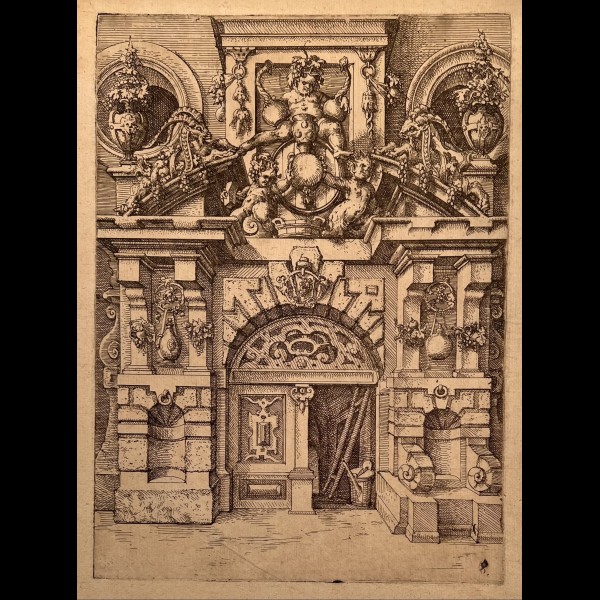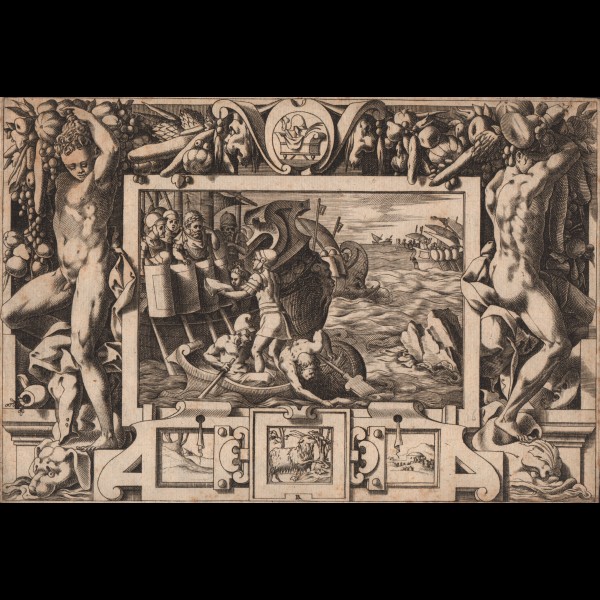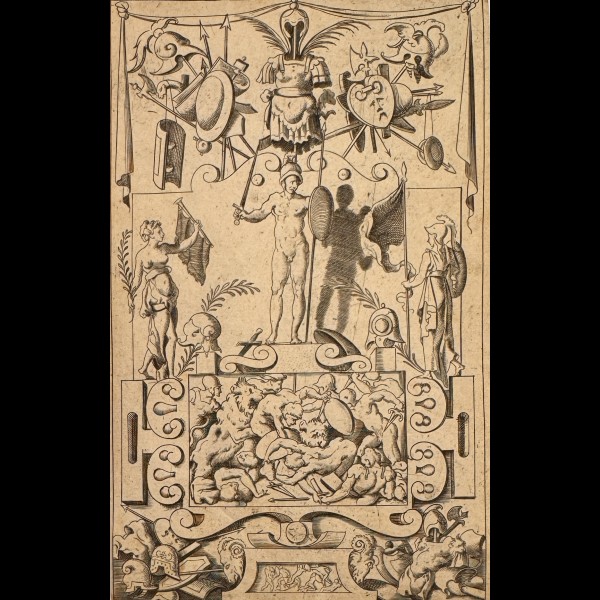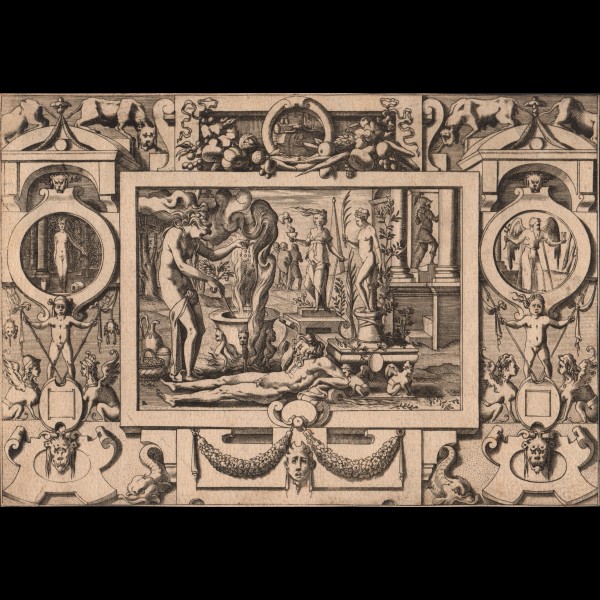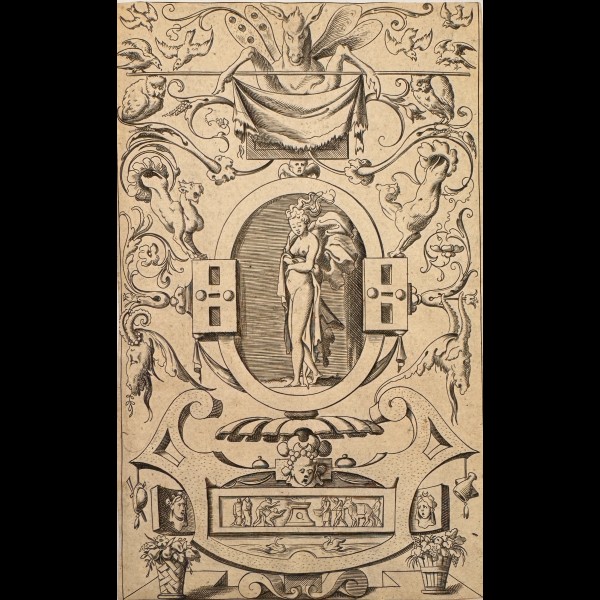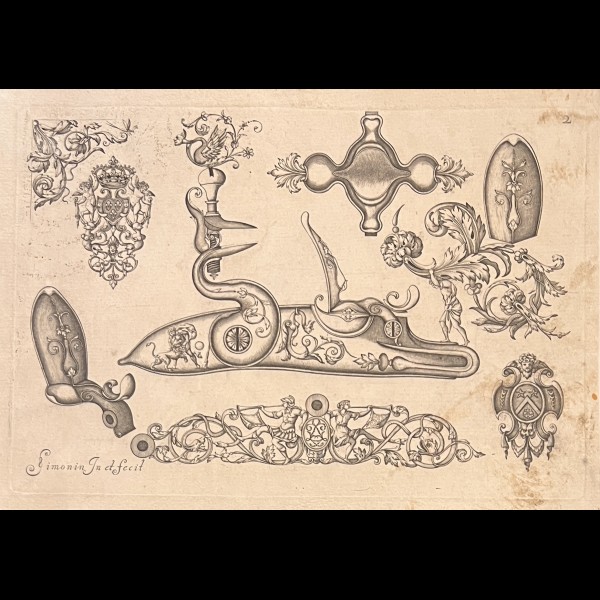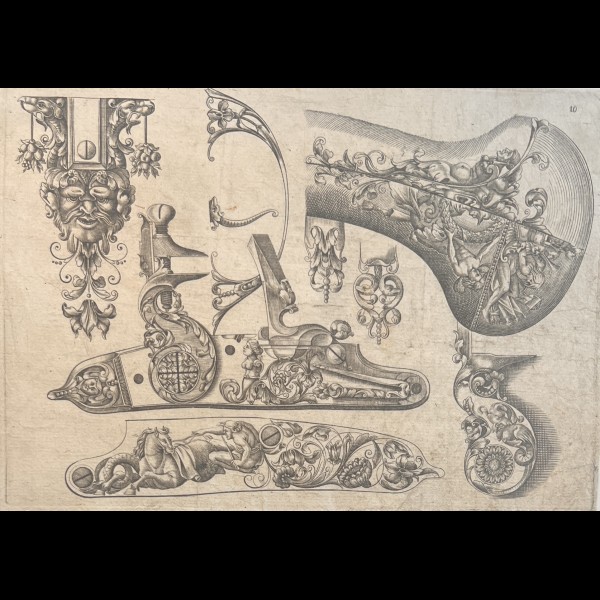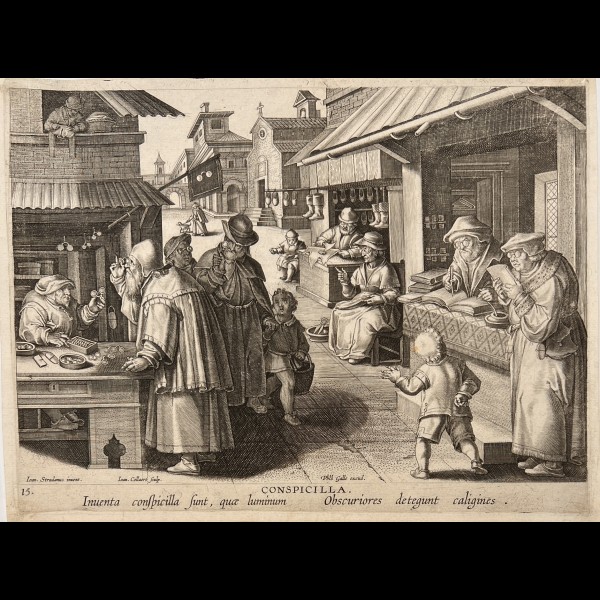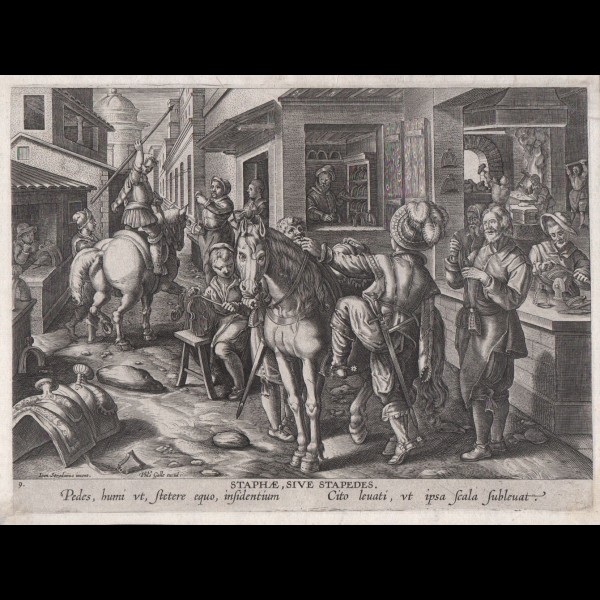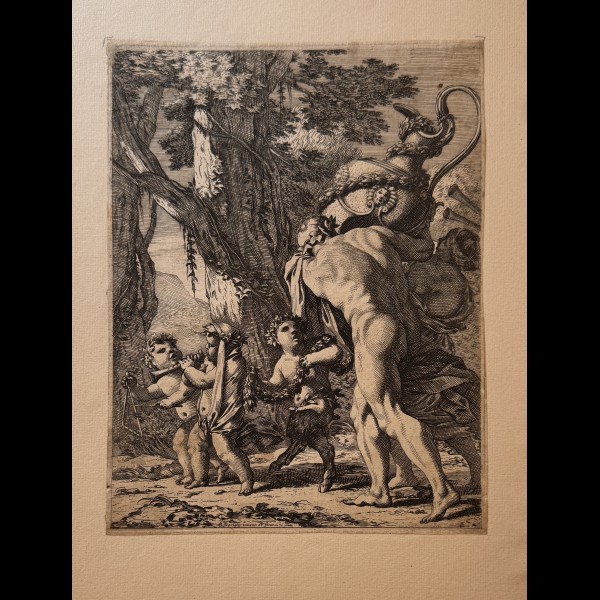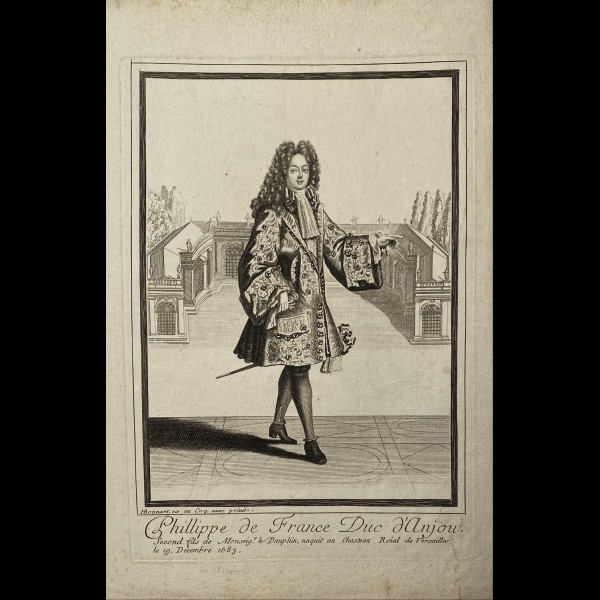FREDERIC III. ELECTEUR DE BRANDEBOURG
MARIETTE JEAN (1660-1742)Proof published in Paris by Mariette. Margin nets, two short tear at the top, one of which reaches the framing line...
L'ADORATION DES ROIS MAGES
ANONYMESuperb event with net margins, we distinguish Bethlehem left and probably the castle Saint Ange. This unusual print is included in the BNF catalog on: First Italian engravings (396.A)Reference : Bartsch, T.XIII.39.I ; Hind I.284.16 at the adress of Antonio Salamanca..
MARS
BEHAM HANS SEBALD (1500-1550 )From the following: Seven planets with the zodiacs (B.: 113 to 120) State IV / IV with recovery on the top of the thighs. Beautiful print cut to the limit of copper. Bartsch: 118..
ORNEMENT AVEC UNE FRISE D'HOMME A MI-CORPS ENTOURE PAR DEUX GENIES
BEHAM HANS SEBALD (1500-1550 )Old copy in counterpart of Beham's version (cf. Bartsch: 86).Collection mark on the back of LEROY KIRWIN BURKET (1920-Akron 2003), artist and collector (Lugt: 3389)...
MARCHE D UN CHAR AYANT LA FORME D UN VAISSEAU
DELLA BELLA STEFANO (1610-1664)From the following: Combattimento e balletto a cavallo (Carrousel represented in Florence De Vesme 65 to 68) Nice proof De Vesme: 66..
CARTOUCHE AVEC UN ECUSSON BLANC
DELLA BELLA STEFANO (1610-1664)Plate n ° 5 from the following: Raccolta Di Varii Cappriccii Et Nove Inventtioni Di Cartele Et Ornamenti (DV: 1027 to 1044) State I / III before the order number De Vesme: 1031 Proof cut to the limit or slightly to the inside copper, three brown spots on the back in the upper border...
DEUX DRYADES OU FEMMES TRANSFORMEES EN ARBRES ( MYRRHA ET DAPHNE ? )
DELLA BELLA STEFANO (1610-1664)Cartridge n ° 6 in the following: New inventions of cartridges 1647 De Vesme: 1020 Good impression, proof cut to the limit of copper...
AUTRE FUITE EN EGYPTE
DELLA BELLA STEFANO (1610-1664)State III/IVProof before the removal of the excudit and privilege.De Vesme: 12Cut at the copper limit, inscription in brown ink at the top left, on the back thinning of the paper at three of the angles...
PREMIER COMBAT NAVAL
CALLOT JACQUES (1592-1635)State I/II before the inscriptions in the margin.From the suite: The life of Ferdinando I de Medici (Lieure : 147 to 162)Engraved and printed by Callot in Florence in the office workshop which had been allocated to him.Ca.1619-1620Watermark n°3: at the three rocksGood proof with short margins.Lieure: 157..
LA FACTORIA
CALLOT JACQUES (1592-1635)From the set : Caprices, second version engraved in NancyBeautiful print cut to the limit of copperLieure : 433 Etat I/II..
DANSEUSE EN COSTUME DE FANTAISIE
LEPAUTRE JACQUES (ca.1653 – 1684)Superb proof of the first state with beautiful marginsReference: I.F.F n° 32 State I/III..
PATER NOSTER
WIERIX HIERONYMUS (1553–1619)Pater Noster qui es in coelis sanctificetur nomen tuum, burin with short margins after HeemskerckNagler : 167..
BARQUEROLE DE VENISE JOUANT DU FIFRE ET DU TAMBOURIN A L'OPERA
BONNART NICOLAS (1637?-1718)Proof in beautiful antique color with heightened gold and silver, consolidated tears in the upper and lower margins not affecting the subject, slightly yellowed paper.Reference : Le Blanc n° 182..
L'EMPEREUR COMMODUS EN HERCULE OU HERCULE COMMODE
BOS JACOB (1549-1580)Proof executed in 1550 and edited by Antonio Lafreri (1512-1577), near Bernstein filigree: cote 46853 (between 1567 and 1600) Very nice impression Hollstein: 16..
DIEU ORDONNANT A NOE DE BÂTIR L'ARCHE
DENTE DA RAVENNA MARCO ( 1486/1500-1527 )According to Marc-Antoine Raimondi, after a drawing by Raphaël Reference: Bartsch No. 3.ANice proof..
LA FRESQUE DE LA BATAILLE DU PONT MILVIUS
DENTE DA RAVENNA MARCO ( 1486/1500-1527 )Also say: Battle scene in a landscape with men on horseback, several others on the ground and a group of horsemen in the background.From a drawing by Raphaël.The fresco was produced and painted by Giulio Romano for Constantine's room in the Vatican.To Carlo Losi's address.Late 17th century print.Bartsch : 420Copper cut proof...
LE MARTYRE DE SAINT SEBASTIEN OU LE ROI MORT PERCE DE FLECHES
ZASINGER MATTHAUS (c.1477-1533)Intituled " The martyr of Saint Sebastian" it coul be an episode taken from the "Gesta Romanorum" (The Acts of the Romans) where the print illustrates the episode of the dead king pierced by the arrows of his sons. Filigree "Eagle with one head" (near Briquet 183 or 191) Collector's mark on the back "CD", known by Lugt but not yet indexed, for Carl Drandt (born in Darmstadt in 1842)Very nice impression Reference: Bartsch: 4 (Master MZ)..
OISEAUX, PLANCHE III
LE ROY HENRY (1579-1651)Plate from a set of six at the adress of Herman Weyen ( 1643 et 1680 ) engraver and editor in Paris.these patterns are elements of an engraved set by par Nicolaes de Bruyn ( Volatilium Varii Generis)Good proof, some creases and stains mainly in large margins. Guilmard: p.38 and Berlin K.O.S : 4380..
ZEPHYR ENLEVANT PSYCHE SUR LES ORDRES DE L'AMOUR
DADDI BERNARDO (ca. 1512-1570)Print from the set : La Fable de Psyché afterRaphaël Copy in the same direction after Daddi ( cf .Bartsch XV.223.69 )Few brown spots...
LE PERE DE PSYCHE CONSULTANT L'ORACLE
DADDI BERNARDO (ca. 1512-1570)Print from the set : La Fable de Psyché afterRaphaël Copy in the same direction after Daddi ( cf .Bartsch XV.223.69 )..
La victoire de Scipion sur Syphax
DADDI BERNARDO (ca. 1512-1570)Very nice proof with a net of margins carrying a filigree with lilyReference : Bartsch : 73..
APULEE CHANGE EN ANE ECOUTANT LA FABLE DE PSYCHE
DADDI BERNARDO (ca. 1512-1570)Print from the set : La Fable de Psyché afterRaphaël Copy in the same direction after Daddi ( cf .Bartsch XV.223.69 )Short tear in the upper margin not reaching the subject, small restoration, some brown spots...
ENSEVELIR LES MORTS
PENCZ GEORG (CA.1500-1550)Print from the set : Seven works of mercy.Proof cut at the edge of the subject, slight thinning of the paper on the back...
THETIS ET CHIRON
PENCZ GEORG (CA.1500-1550)Nice proof, margins, some scattered rednessesBartsch : 90, Hollstein : 119..
MASCARON 7
GHISI ADAMO (1530–1585)Nice proof from the set : Mascarons after Giulio Romano (B.108-127), stain in the left outer borderEarly 17th century printBartsch : 114..
MASCARON 17
GHISI ADAMO (1530–1585)Nice proof from the set : Mascarons after Giulio Romano (B.108-127), stain in the left outer border.Early 17th century print.Bartsch : 124..
BACCHANALE
BREBIETTE PIERRE ( 1598- Ca 1650 )Plate of a series of: Bacchanalia and sacrifices offered by satyrs (IFF: 144 to 155) Nice proof margins nets Reference: Inventory of the French Fund n ° 151..
BACCHANALE
BREBIETTE PIERRE ( 1598- Ca 1650 )Plate of a series of: Bacchanalia and sacrifices offered by satyrs (IFF: 144 to 155) Nice proof margins nets Reference: Inventory of the French Fund n ° 150..
BACCHANALE
BREBIETTE PIERRE ( 1598- Ca 1650 )Plate of a series of: Bacchanalia and sacrifices offered by satyrs (IFF: 144 to 155) Proof slightly cut inside or at the limit of copper, the upper corners redone.Reference: Inventory of the French Fund n ° 147..
BACCHANALE
BREBIETTE PIERRE ( 1598- Ca 1650 )Plate of a series of: Bacchanalia and sacrifices offered by satyrs (IFF: 144 to 155) Nice impression slightly cut inside the copper.Reference: Inventory of the French Fund n ° 146..
DAVID DECHIRANT SES VETEMENTS A L'ANNONCE DE LA MORT DE SON FILS
ALDEGREVER HEINRICH ( 1502-1558 )From the continuation of: The History of Amnon and Tamar (B: 22 to 28) State II / II Bartsch: 28 Proof with small margins, tiny tear in the right margin not reaching the subject. Remains of old assembly with three angles on the back. Unidentified (collector's brand ?) mark on the back, letter v in a red circle...
LE BON SAMARITAIN
ANONYME XVIèAfter Aldegrever: the story of the good Samaritan (cf. Bartsch: 40 to 43)Stamp on the back of the L.K.B collection(Leroy Kirwin Burket (1920-2003) artist, teacher of fine arts in the United States, great collector of old masters)..
LE GOUT
ANONYME XVIèAfter Saenredam. From a set of : Cinq senses Proof cut with a square line or slightly inside, restoration in the upper left corner...
IONICA ODOR
HONDIUS HENDRICK ( 1573-1650 )Ionic Order or Smell.Plate after Jan (or Hans) Vredeman de Vries (1526-circa 1609) from the following: "The Five rows of architecture, to know: Tuscan, Doric, Ionic, Corinthian, and composed, with basic instruction, made by Henricus Hondius. Amstredam [sic], Jean Jeansson ".Vredeman de Vries (1526-circa 1609) Flemish painter, occupied an essential place in Flemish architecture of the Renaissance, in particular for his ideas and theories on the perspective which he disseminated through his publications.Each of the orders is enriched with an allegory of one of the five senses.Between 1617 and 1620Hollstein: 161 Good proof, short tear in the left margin, tiny points of freckles mainly visible on the back, usual median fold of tab...
ANGELIQUE ET MEDOR
GHISI GIORGIO (1512/1520–1582)Beautiful subject illustrating the loves of Angelique and Medor taken from the Orlando furioso (or Roland furious) epic poem in Italian composed by Ludovico Ariosto, called "Ariosto", at the beginning of the 16th century, composed of 46 songs in ottava rima , counting 38,736 vers.After Teodoro Ghisi, 17th century print by Giacomo Rossi.Reference: Bartsch n ° 410Remains of a strip of old mounting on the back..
SAINT THOMAS
DE PASSE CRISPIJN ( 1564 ? - 1637 )Print from the set : Christ and the Apostles (H. 240 to 253) 1594 Reference: Hollstein n ° 248Good impression cut to the limit of copper and mounted on a page of an old album...
FIGURE DE L'HABIT DE CHEVALLIER (SIC) A LA PLUVINELLE
DE PASSE CRISPIJN ( 1564 ? - 1637 )Good impression, usual median fold, slightly yellowed borders, three old restorations in the large margins not reaching the subject.From : " L'instruction du Roy en l'exercice de monter a cheval . Par messire Antoine de Pluvinel, son soubs-gouverneur, conseiller en son Conseil d'Estat, chambellan ordinaire, & son escuyer principal. Lequel respondant a Sa Majesté luy faict remarquer l'excellence de sa methode pour reduire les chevaux en peu de temps à l'obeyssance des justes proportions de tous les plus beaux airs & maneiges. Le tout enrichy de grandes figures en taille-douce, representant les vrayes & naïsves actions des hommes & des chevaux en tous les airs, & maneiges, courses de bague, rompre en lice, au quintan, & combattre à l'espee, ensemble les figures des brides, les plus necessaires à cet usage, desseignees & gravees par Crispian de Pas le jeune ""A Paris, chez Michel Nivelle, ruë Sainct Jacques, à l'Escu de Bretagne, devant l'eglise Sainct Benoist. M. DC. XXV. Avec privilege du Roy, pour six ans"1625This famous treatise on riding, supported by philosophical remarks, is written in the form of interviews for the attention of the young Dauphin (future Louis XIII). To introduce him to the art of "reducing horses to obedience in a short time", Antoine de Pluvinel softened the teaching he himself received in Italy. It is illustrated by Crispin de Passe, whom Pluvinel met in Holland during one of his diplomatic missions...
SAINT JACQUES LE MINEUR
DE PASSE CRISPIJN ( 1564 ? - 1637 )Print from the set : Christ and the Apostles (H. 240 to 253) 1594 Reference: Hollstein n ° 249 Good impression cut to the limit of copper and mounted on a page of an old album...
LA PARABOLE DU BON SAMARITAIN
VOLCKERTSZ COORNHERT DIRCK (1522-1590)After Maarten van Heemskerck Proof cut with a square line, two printing folds, tiny consolidated tear in the right border. Hollstein: 105 to 108..
HISTOIRE DE JACOB
VOLCKERTSZ COORNHERT DIRCK (1522-1590)Test with fillets of margins, small coloring on one of the sheep of the flock..
LA CREATION D'ADAM
DELAUNE ETIENNE ( 1519-1583 )From the set: "History of Genesis"State I/II before addressNice print, cut at the copper limit, remnants of old mounts on the back, some small brown stains and thinning in the borders on the back.Bartsch: 25Carries three collector's brandsLugt.1731 ( and L.1701 ):" L. LÉPINGLE († around 1903), merchant, Brussels. Prints.L. Lépingle, a former ironmonger, owned a collection of ancient and modern prints which was purchased, perhaps only in part, by the print dealer Bihn, of Paris.The collector used, in addition to the mark reproduced, a stamp offering his initials in Roman characters (We have not yet encountered the third mark, cited by Lugt in 1956, offering the initials of the collector in Roman characters Romans), and a third giving his name in full.The Hermitage Museum in Saint Petersburg holds a set of twenty-two prints by Ignace Joseph Claussin after de Boissieu, eleven of them jointly bearing the marks L.1731 and L.1701, and two among them the marks L.1672b, L.1731 and L.4169 (archives of the Custodia Foundation, letter dated October 24, 2013).In several sales catalogs, the mark L.1731 was reported on prints accompanied by another unidentified mark, an initial L, stamped in blue-green ink; this has sometimes been identified as L.1701 (for example sale 2009, September 16, London, Christie's, n° 86, Rembrandt, The Flight into Egypt or online sale 2018, November 28 to December 6, Christie's, n° ° 99, Rembrandt, The Last Supper), or else described without mentioning the Lugt number (sale 2009, April 8, London, Christie's, no. 49, Rembrandt, Self-portrait with Saskia; sale 2004, November 25, Haarlem, Bubb Kuyper, no. 3527, W. Panneels, San Sebastian). This mark L.1701 is probably related to the collection of L. Lépingle. So many prints where the two marks, L.1701 and L.1731, appear together lead us to think that they may be linked.Note that this mark had been reported on a drawing given to Donato Creti (1671-1749) in the catalog of the Galerie Prouté in 1975, without specifying its color (cat. Prouté, Catalog “Dandré-Bardon”, Paris 1975, #8).The L.1731 mark may be affixed in blue, blue-green and/or red."Lugt:4172 (This is a larger size variant of the L.4171 mark): "CHARLES-FRÉDÉRIC MEWÈS (Strasbourg 1858-1914), architect, London. Ornamental and architectural drawings and prints .Charles Mewès (sometimes written Mewes), originally from a Jewish family in the Baltic countries, was the son of a merchant, Frédéric Mewès, and Julie Laure Schutzenberger. The family left Alsace in 1870 during the Prussian occupation. Charles entered the office of Jean-Louis Paul (1837-1920), a famous architect and teacher at the Beaux-Arts in Paris, at the age of twenty. In 1885, he competed for the Prix de Rome and graduated the following year. In 1900, he joined forces with the British architect Arthur Joseph Davis (1878-1951), his former classmate at the École des Beaux-Arts, and formed the “Mewès et Davis” agency. Charles Mewès owes his reputation as an architect to ..
JUILLET
DELAUNE ETIENNE ( 1519-1583 )Print from the set : Twelve months Reference: Robert-Dumesnil n°191; IFF 16th century n ° 194Proof cut inside copper, formerly mounted on a large sheet of laid paper ( 235x310 mm) probably from an album..
LES DOUZE MOIS DE L'ANNEE
DELAUNE ETIENNE ( 1519-1583 )First set of: Twelve Months, or the different occupations of men during the year.Suite of twelve prints in oval shapes.Beautiful proofs with margins presented together on an old montage.Some tiny foxing in the outer edges.Below is the description as given by Robert-Dumesnil: 185. January.(1) Interior of a dining room where a husband and wife are seen, people of distinction seated at the table, served by a maître d'hôtel and a cupbearer. This room adjoins a kitchen where a woman holds a frying pan on the fire.Aquarius and its celestial sign can be seen at the top of the room, towards the back.186. February.(2) To the left of the print we see a seated old man warming himself at a fireplace where a woman is approaching, spinning with a spindle, having a chaplain hanging from her belt; a servant follows her bringing wood. Pisces and their sign are seen in the middle of the top. Externally we can see, at the back of the right, a lumberjack who is felling wood.187. March.(3) A man and a woman are busy pruning the vine. In the middle of the top appears Aries and its astronomical sign.188. April.(4) In the middle of the front of this piece we see a shepherd sitting talking with a shepherdess who is weaving flowers and a young girl who is picking them; beyond a herd is scattered. In the middle of the top appears the Taurus and its astronomical sign.189. May.(5) In the middle of the front of this piece we see a young girl sitting facing front who sings to the accompaniment of the cittern.She is between two other young people, one of whom is holding a bouquet in one hand and a crown of flowers in the other.Gemini appears in the middle of the top as well as their celestial sign.190. June.(6) On the front of this print we are busy shearing the flock, an operation carried out by a young woman assisted by two shepherds who bring or bring her two sheep. In the middle of the top is Cancer and its astronomical sign.191. July.(7) The right of this piece shows two men busy mowing. Leo is seen in the middle of the top accompanied by its astronomical sign.192. August(8) Four men take care of the harvest work on the front of this piece; three saw the wheat and another tied it into sheaves. In the middle of the top we see the Virgin and her astronomical sign.195. September.(9) Plowing and sowing the land. In the foreground we notice a farmer who, walking to the right, sows a field. To the right of the background we notice another one driving his plow on a patch of earth. In the middle of the top appears Scorpio (*) and its astronomical sign.(*) It is very inappropriate that Scorpio appears in this month and that in October that of Libra appears; there is obviously a transposition of the constellations(...)196. October.(10) The harvest. The grapes are brought and crushed into a vat in the middle of the front, and the wine is drawn off; three men take care of it. The surplus from the operation is done at the bottom. In the middle of the top we see Libra and its astro..
NOVEMBRE
DELAUNE ETIENNE ( 1519-1583 )Print from the set : Twelve months Reference: Robert-Dumesnil n°195; IFF 16th century n ° 198Proof cut inside copper, formerly mounted on a large sheet of laid paper ( 235x310 mm) probably from an album..
L'HOMME AU DRAPEAU
VENEZIANO AGOSTINO ( 1490- CA.1540 )Print which would be engraved after the version of RaimondiBartsch: 482Proof cut on three sides at the copper limit and at 8 mm in the subject at the top...
LA DESCENTE DE CROIX
HOPFER LAMBRECHT ( CA. 1500 – CA. 1535 )Proof after the Little Passion by Durer, from the XVIIth century with the numbers of the merchant Funck.Lined proof, cut to the limit of copper.Bartsch : 13..
BLASONS
HOPFER HIERONYMUS (1500?-1563?)XVIIth edition with the number of the merchant Funck.Bartsch: 76Cut to the limit of copper...
COSTUMES POUR LES FETES DONNEES PAR LE DUC FRIEDRICH DE WURTEMBERG
KUCHLER BALTHASAR ( 1571-1641 )Plate from: Repraesentatio Der Fürstlichen Auffzug und Ritterspil [...]. Schwäbischn Gmund, Küchler, s.d. [1611]Book immortalizing the celebrations which took place in Stuttgart in 1609 for the princely weddings of Johann Friedrich, Duke of Württemberg, and Barbara Sophie, Margravine of Brandenburg, composed of illustrations entirely engraved on copper by Balthasar Küchler (circa 1571-1641), painter from Silesia who made his career in Schwäbisch Gmund in Germany.Hollstein : 1-239Proof cut at the edge of the copper, formerly lined, a few scattered spots, old handwritten annotation in brown ink in the lower part...
SATURNE
MAITRE I.B ( ACTIF CA.1520-1530 )Proof cut to the limit of copper, laminated on paper.The monogrammist IB was a German engraver active in Nuremberg around 1520-1530Bartsch: 11..
ORNEMENT, FLEURS ET LIBELLULE
SADELER JOHANNES ( 1550-1600 )Plate from a series of ornaments of flowers, insects and various animals. Edited by Sadeler. Beautiful print, two small galleries of restored verses in the margins...
MERIDIES
SADELER JOHANNES ( 1550-1600 )from the rest of the four hours of the day (Hollstein: 509 to 512) after Dirck BarendszSlightly yellowed ProofHollstein : 510..
L'HUMANITE EN ATTENTE DU JUGEMENT DERNIER
SADELER JOHANNES ( 1550-1600 )After D. Barendsz.Proof with a margin net and marked in the lower right corner with a number in brown ink.Hollstein: 265The key to reading this print is found in the Bible verses at the bottom: "Ita erit et adventus filii hominis", referring to chapter 24 of the Gospel of Matthew: "38- In those days, before the deluge, we ate and we drank, we took a wife and we took a husband, until the day when Noah entered the ark; 39- people did not suspect anything, until the deluge that brought them all swallowed up: such will also be the coming of the Son of man. "..
LA LAMENTATION
SADELER JOHANNES ( 1550-1600 )Print from the set : The Passion (Hollstein 207 to 220) after Marcus Geerarts.Reference: Hollstein n ° 218Beautiful impression cut at the edge of the subject and reassembled formerly..
RHETORICA
SADELER JOHANNES ( 1550-1600 )Print after M.de Vos, from the suite of: Liberal Arts (Hollstein: 545 to 552)Cut to the limit of the square line.Hollstein: 548..
CHRIST AUX OUTRAGES
SADELER JOHANNES ( 1550-1600 )Print from the set : The Passion (Hollstein 207 to 220) after Marcus Geerarts.Reference: Hollstein n ° 216Beautiful impression cut at the edge of the subject and reassembled formerly..
HERCULE ET IOLAUS TUANT L'HYDRE DE LERNE
CARAGLIO GIOVANNI GIACOMO ( 1500/1505-1565 )Plate from a set of six (Bartsch 44 to 49) after Rosso Fiorentino.XVIIth edition.Print cut at the copper limit...
DIVERS COSTUMES
DE BRUYN ABRAHAM (1540?-1587)Plate executed for the work: Omnium pene Europae, Asiae, Aphricae atque Americae gentium habitus (Clothes of various nations of Europe, Asia, Africa and America), published between 1577 and 1610Reference : Hollstein n° 248 à 306Belle épreuve..
DIVERS COSTUMES FEMININS DE L'EUROPE DE L'EST
DE BRUYN ABRAHAM (1540?-1587)Plate executed for the work: Omnium pene Europae, Asiae, Aphricae atque Americae gentium habitus (Clothes of various nations of Europe, Asia, Africa and America), published between 1577 and 1610Reference : Hollstein n° 248 à 306Nice proof..
DIVERS COSTUMES DE L'ALLEMAGNE
DE BRUYN ABRAHAM (1540?-1587)Plate executed for the work: Omnium pene Europae, Asiae, Aphricae atque Americae gentium habitus (Clothes of various nations of Europe, Asia, Africa and America), published between 1577 and 1610Nice proof with margins, filigree fleur de lysReference : Hollstein n° 248 à 306..
SAINT LAURENT
DE LEU THOMAS ( CA.1555-1612 )From the following: Seven main churches of Rome, with the portrait of their Patron Saint (Robert-Dumesnil: 28 to 34)R.D: 32Three small wormholes...
SAINT PAUL
DE LEU THOMAS ( CA.1555-1612 )From the following: Seven main churches of Rome, with the portrait of their Patron Saint (Robert-Dumesnil: 28 to 34)R.D: 30Two small wormholes...
FONTAINE DE LA PORTE ST.DENIS. FONTAINE DE LA CHARITE. FONTAINE DES PETITS PERES NOIRS.
PERELLE GABRIEL (1604-1677 )From the suite engraved in collaboration with his two sons Nicolas (1625-1692) and Adam (1640-1695): "Views of the most beautiful Houses of France - The Squares, doors, fountains; churches and houses of Paris. - Views of the beautiful Houses of the surroundings of Paris. - Views of the most beautiful places of Versailles. - Views of the most beautiful Houses of France. - Various views of Chantilly. - Views of Rome and the surroundings "1670..
LE JET D'EAU, CHANTILLY
PERELLE GABRIEL (1604-1677 )Double printing, one for the view the second for the cartridge.Nice print with large margins, brown spot in the lower left corner...
LA PERSPECTIVE DANS LA MAISON DE MR LE MARQUIS DE DANGEAU
PERELLE GABRIEL (1604-1677 )The Lafont hotel (also known as the Breteuil hotel, the Dangeau hotel, the Missan hotel or the Sainson hotel) is a private mansion located at 12 place des Vosges. It is located on the east side of the square, between the Châtillon and Ribault hotels. From the following: Views of the most beautiful places in France and Italy. Beautiful print, two points of rust in the lower margin, halo in the upper margin not reaching the subject...
ARC DE TRIOMPHE HORS LE FAUXBOURG SAINT ANTOINE
PERELLE GABRIEL (1604-1677 )From the suite engraved in collaboration with his two sons Nicolas (1625-1692) and Adam (1640-1695): "Views of the most beautiful Houses of France - The Squares, doors, fountains; churches and houses of Paris. - Views of the beautiful Houses of the surroundings of Paris. - Views of the most beautiful places of Versailles. - Views of the most beautiful Houses of France. - Various views of Chantilly. - Views of Rome and the surroundings "1670..
HISTOIRE DE L'ENFANT PRODIGUE
BOSSE ABRAHAM ( 1605-1678 )Complete suite of six framed prints (Blum: 1184-1189; Duplessis: 34-39) in a homogeneous edition, all with margins or margins with the exception of the Festin cut at the limit of the border. -The Prodigal Son leaves the paternal home Skillfully restored transverse tear, fine dubbing, tiny brown stain. -The Prodigal Son in a bawdy-house, uncovered version State II / III before the modifications on the panties of the man in the kitchen and the recovery on the hand of the Prodigal Son to make the board more "decent". On this piece the mention "du Roy"as well as the address of the publisher undoubtedly erased because of its scabrous character and re-established in the last version considered more suitable. Two old traces of brown ink in the most nimble places. -The Prodigal Son keeps the pigs Tiny brown spot in the border. -The Return of the Prodigal Son -The Prodigal Son changes his clothes Two traces of pencil in the sky and on the column. -The Feast of the Return The parable of the Prodigal Son is the subject of almost the entire chapter XV of the Gospel according to Saint Luke. Bosse respects the letter but he nevertheless watered down the end as was previously the case with many other artists very inspired by this theme, such Dürer, Beham, Mérian (who was one of the masters of the Bosse) or Callot whose slightly earlier sequel maintains a discreet relationship with it. (cf.: Abraham Bosse, learned engraver, BNF, Museum of Fine Arts in Tours, 2004)Each, at sight approximately 250 x 320 mmWith the frame 405 x 460 mm..
LE SCULPTEUR DANS SON ATELIER
BOSSE ABRAHAM ( 1605-1678 )Beautiful print trimmed to the edge of the square line, the upper left corner redone.1642Blum: 204"In his studio, a sculptor receives three visitors, two women and a man, elegantly dressed. One of the women is ecstatic before a large marble statue of Venus and Cupid standing on a pedestal to the right. On the pedestal are a mallet and a chisel, against it a compass, and on the ground clasps (a type of gouge) and a brush. The statue is reminiscent of the work of the sculptor Jacques Sarazin (1592-1660), notably the groups created for the Château de Wideville, on which the architect Thomas Francini also collaborated. The sculptor, who holds a chisel in his right hand, presents with his left the miniature model that served as a guide for the creation of his marble statue.To the left, on a stand, is a man's head; on a table behind, several wax models, wax on paper, and a modeling tool; behind it, on a small table, two wax models, one of which, in progress, is covered with a damp cloth to prevent it from drying out too quickly. On shelves at the back of the studio, as well as on the floor, are various examples of our sculptor's work. On the left, we notice a statue of Strength, and on the right, a group with a river god; between the two, a cartouche carved with the coat of arms of Cardinal Richelieu. Behind the visitors, a funerary sculpture can be partially seen."Abraham Bosse and the Royal Academy"Reason above all" by Sophie Join-Lambert, an article written as part of "Abraham Bosse, learned engraver" at the Bibliothèque nationale de France from April 20 to July 11, 2004...
UN SEIGNEUR A CHEVAL ET SA DAME
BOCKSTORFFER CHRISTOFFEL ( CA.1480-CA.1553 )The artist's monogram appears in the banner at the bottom right: "CB" with the pine cone, mark of Bockstorffer.State II / II with the publisher number David Funck (1682–1709) at the bottom left.Proof cut slightly inside the copper.XVIIth edition.Hollstein: 4..
ST FRANCOIS RECEVANT LES STIGMATES
BOLDRINI NICCOLO ( ACTIF CA.1540-1566 )After TitianCa.1540Proof cut to the framing line.Passavant : VI.59..
LA NAISSANCE DE ST JEAN BAPTISTE
BONASONE GIULIO (1498-1576 )After Le Pontormo.State II / II at the address of the publisher Lafreri.Scattered freckles, small lack in the restored subject, margin nets.Bartsch: 76...
SEMELE
BONASONE GIULIO (1498-1576 )Semélé from the following : Amours des Dieux Bartsch: 156 Copper cut proof formerly raised on a border, a few scattered red spots..
JESUS PARMI LES DOCTEURS
RAIMONDI MARCANTONIO ( CA.1480-CA.1534 )From the series of Dürer: The life of the Virgin.(Bartsch 621 to 637)Remains of old mountings on the backBeautiful proof cut with the copper mark bearing the stamp of the Arenberg collection, followed by two numbers with graphite lead (probably for one of them affixed before the sale in 1902).Collection of ARENBERG, Brussels and North-Kirchen (Westphalia). Prints. (Lugt: 567)The princes, then dukes of Arenberg counted, in Belgium, since the XVIth century, among the greatest protectors of the arts. It was the duke Louis-Engelbert d'Arenberg (1750-1820) who contributed the most to enrich the collection of prints of his house. Duke Engelbert-Marie, born in 1872, lightened his boxes with a large quantity of prints, which he put on sale in public sale in London (40,000 sheets described under 669 nos).The brand is borrowed from the coat of arms of the house of Arenberg: Gules with 3 flowers of golden medlar, 2 and 1, with the motto: “Christus Protector meus. "Bartsch: 635..
LA NAISSANCE DE LA VIERGE
RAIMONDI MARCANTONIO ( CA.1480-CA.1534 )After Baccio Bandinelli.Edited by Antonio de Salamanca (1478-1563) who worked in association with the printer Antonio Blado and, from 1553 to 1563, with the French printer and engraver Antoine Lafrery.Ca.1540Five short tears restored, copper cut proof.Bartsch: T.XV, p.9.II.1..
PORTRAIT DE MICHEL ANGE AGE DE 74 ANS
BIANCHI OU BLANCUS CRISTOFANO ( ACTIF A ROME CA.1598-1612 )Margin netting, light uniform dusting, posterior printing. Le Blanc : 7..
LA SAINTE FAMILLE
FRANCO GIOVANNI-BATTISTA ( 1498-1561 )watermark: GBL in a circle. Bartsch: 27 Margin net, thinning of the paper at the corners, small missing in the upper margin.Early 17th century print...
APOLLON SE TENANT DERRIERE UNE FEMME OU ALLEGORIE DE LA PEINTURE
BONASONE GIULIO ( 1531-1574 )From the suite : The Loves of the Gods' 1531-1560 Proof cut at the limit of the square line, short tear of 3 mm in the right border, some foxing mainly visible on the back, upper left corner cropped.Bartsch: 161..
LA VIEILLE FEMME ENDORMIE
BRETHERTON JAMES ( CA.1730-CA.1790 )Copy of Rembrandt's version, engraved around 1770. Copper-cut proof..
SAINT BENOIT RECEVANT DES PRESENTS
GIOVANNINI GIACOMO MARIA (1667-1717)From the set The life of St Benoit after Guido ReniAfter the cycle of S. Michele del Bosco, consisting of a frontispiece and 19 plates. Plate n ° 3 1695Fine proof with all untrimmed margins, usual median fold..
BADVILA OU TOTILA DEVANT SAINT BENOIT
GIOVANNINI GIACOMO MARIA (1667-1717)From the set The life of St Benoit after Lodovico Carracci After the cycle of S. Michele del Bosco, consisting of a frontispiece and 19 plates. Plate n ° 9 1695 Bartsch XIX.427.29 Fine proof with all untrimmed margins, usual median fold..
LE FILS PRODIGUE : LE RETOUR
MONOGRAMMISTE MT ( TREU MARTIN ?) ( ACTIF ENTRE 1541 ET 1543 )Proof cut to the limit of copper.Two small restored holes, one at the level of the father's belt, the other on the coat of one of his brothers.(On the back: mark? Not identified)Bartsch : 13The identification of this monogramist happens to be problematic. Christ the First, in his Dictionary of Monograms (1750, reprinted 1972, p. 231), attaches to the name of Martin Treu the monogram formed by the letters M. T. He thus declares Martin Treu engraver, apparently basing his explanation on a comparison arbitrary between the two letters and the aforementioned name. The engravings bearing this monogram are for the most part dated, which allows us to locate the artist's activity between 1540 and 1543. Following Christ, the identity of the monogramist, although arbitrarily established, and underlined as such in the biographical notes of artists, will however be maintained. We have no documentation on his place of birth or residence. G. K. Nagler (Neues allgemeines Künstler-Lexikon, 21st vol, 1835-1852, pp. 290-293) integrates the engraver into the 'little masters' and proposes Nuremberg as a city of anchorage. In the absence of real references to a place of activity, A. Andresen, following on from Nagler, evokes on the other hand, a probable belonging to the Saxon school (Die Monogrammisten und diejenigen bekannten und unbekannten Künstler aller Schulen, IVe vol ., 1871, pp. 687-689). According to him, Treu's engravings would recall the style of Hans Brosamer (circa 1500-circa 1552) and even sometimes attempt to imitate that of Aldegrever. Bartsch, (IX, p. 68, et seq.), Mentions forty-two works linked to this engraver. He underlines the rarity of good prints and denounces the high price of some. In his work, G. K. Nagler adds two works to the list described by Bartsch, and which Brulliot had declared incomplete in his Dictionary of Monograms (1817, I, n ° 2958). Passavant (1863, IV, p. 52 et seq.) Finds nine additional engravings, to which A.Andresen will add a few tests which had escaped Passavant. The gaps were relatively easy to fill, because the presumed Martin Treu numbered the series; at least in part. Among the most important, we must mention the suite of The dance of the peasants (1542), The dance of the nobles (1542 and 1543, depending on the print), or the parable of the Prodigal Son (1541 and 1543), which is the engraving. dealt with here. A few isolated subjects, such as The Judgment of Solomon (1540), The Wise Virgins (1540) as a pendant to the Mad Virgins, The Peasant Surprising his Wife in the Arms of a Monk (1540) or even a Project for a Dagger with its Sheath ( 1540). The whole fits well with the favorite themes of contemporary engravers.in Cat expo STRASBOURG, The gods like men, 2003 (Palais Rohan) (p. 201)..
MICHEL LE TELLIER
MORIN JEAN ( CA.1605-1650 )After Philippe de CHAMPAIGNEMichel Le Tellier, Marquis de Barbezieux, Lord of Chaville, Étang and Viroflay, French statesman, Chancellor of France in 1677, was born in Paris on April 19, 1603 and died on October 30, 1685. Robert-Dumesnil 76 State II / II Copper cut proof, tiny skin rashes on the left border..
CELEBRATION DE LA PAQUE EN TERRE PROMISE
MULLER JAN HARMENSZ (1571-1628)From the following: Story of Joshua Good Proof.New Hollstein : 22..
ARC DE TITUS
LAFRERI ANTONIO OU LAFRERY ANTOINE ( CA.1512-1577 )Senatus Populus que Romanus Divo Tito Divi Vespasiani Filio Vespasiano Augusto Proof with a watermark: Orb surmounted by a star The date and address of Lafreri lower right. 1548 Fine proof cut at the limit, or a few millimeters beyond, of the copper, three slight folds mainly visible on the back..
CHANDELIER AUX TETES DE BOUCS
LAFRERI ANTONIO OU LAFRERY ANTOINE ( CA.1512-1577 )After Enea Vico (1523-1567)From a series of models for antique candlesticks, probably made by an anonymous artist who published his models through Antonio Salamanca (1552), then Lafreri (circa 1573).Minor marginal soiling, some scattered foxing.Print late 17th, early 18th century..
CHANDELIER AUX IGNUDI
LAFRERI ANTONIO OU LAFRERY ANTOINE ( CA.1512-1577 )After Enea Vico (1523-1567)From a series of models for antique candlesticks, probably made by an anonymous artist who published his models through Antonio Salamanca (1552), then Lafreri (circa 1573).Minor marginal soiling, some scattered foxing, slight paper thinning on the verso in the outer left border.Printed in the late 17th or early 18th centuries.Fuhring : 650..
FAMILLE DEVANT UNE TABLE RICHEMENT DRESSEE
DE BAUDOUS ROBERT WILLEMSZ ( CA.1575-CA.1644 )Blessing. In a dining room, a family sits at a richly set table. The parents and the oldest daughter are seated while the four youngest children are standing. The little one in prayer stands near his mother's knees. To the right, an opening gives onto a garden where on the threshold grows a vine laden with grapes, allegory of maternal fertility referring to Psalm 128. Behind each of the children there is an olive branch, at the same time allusion, through the history of the flood and of Noah's ark, to peace but also through holy chrism, of which it is one of the ingredients to carry out the anointings at various times and more particularly at the beginning of Christian life, the symbol of participation in the strength of God.Eight lines in Latin and five in Dutch accompany the image. Rare print. Hollstein: 71 (see also Joan Savary)Proof cut at the limit or slightly inside the square line, reinforced central fold, restored lower left corner, some small scattered holes and reinforced tears...
VEUE DU CHASTEAU DE VERSAILLES DU COSTE DE L'ORANGERIE ( SIC )
BAUDUINS ANTOINE-FRANCOIS (1640 1700)After Frans van der Meulen 1664 Beautiful and large proof in all margins, usual median fold, slight yellowing on the outer edges. Le Blanc : 20Adam Frans Van der Meulen (Brussels 1632 - Paris 1690) was a pupil in Brussels of Peeter Snayers. Mastering the art of representing horses and landscapes, he was called to Paris by Charles Le Brun, first painter to King Louis XIV and director of the Manufacture des Gobelins. Specializing in battle and hunting painting, he came to reinforce in 1665, the group of artists responsible for immortalizing the image of the king and was retired from 1667. He accompanied Louis XIV on all his travels, his residences and the even followed on the battlefield. He brought to Paris, the engraver Adriaen Frans Boudewyns who became one of his favorite interpreters. This one work forming one of the plates known as the : “King's Cabinet”...
MASCARADES 16
BOISSARD ROBERT ( ca.1570 - ? )Plate number 16 from the suite : Mascarades1597State I/II before numberLe Blanc : 27Inv.B.N : 16..
AARON ASSIS
MATHAM JACOB (1571-1631)After Karel van Mander.Beautiful, old, finely lined print, trimmed to the copperline or slightly beyond.Proof from the Camberlyn Collection, whose mark appears on the reverse.Hollstein: 9Lugt: 514Knight J. CAMBERLYN (1783-1861), officer and art lover, The Hague and Brussels. Prints and drawings.Knight Joseph-Guillaume-Jean Camberlyn, born in Ghent, embraced a military career and served in the Dutch army from 1815 as an administrative captain, much in favor with King William I. He lived in The Hague for a long time. When the 1830 revolution occurred, he had already left the army four years earlier, retaining his sympathies for the House of Orange. He then settled in his homeland, Brussels (corner of Rue Montagne de-la-Cour), confined himself to voluntary solitude, and devoted himself almost exclusively to his love of prints and paintings. He published various articles, including on Memling and other primitives. He seems to have been friends in The Hague with the great collector Baron Verstolk. In contact with all the principal collectors of Europe, he was accustomed to attending the major sales himself. His collection of prints, begun in 1815 with portraits of Nanteuil, became very rich. Following the wish expressed by Camberlyn in his will, it was Guichardot who wrote the catalogue for his sale after his death, an important catalogue of around 4000 numbers of prints (nearly 800 different engravers, 160 rare pieces by 82 anonymous masters) and 391 nos of drawings...
SIBYLLE LIBYQUE
SCULTORI ADAMO ( CA.1530-1585 )PhemonoeAfter Michelangelo.From the set : Prophets and Sibyls1563Nice print, crease in the lower right corner, slight uniform dusting, a spot of rust in the right margin...
AM IN SONTAGDES ADVENTS
FRANCK HANS ( CA.1485 - AVANT 1522 )Beautiful print in old colors with the text on the back, slight uniform yellowing, short tear in the upper border, small scuffs on the back in the corners.Reference: Nagler 1858-79 III.896The typographical text on the prints identifies it as an illustration for one of Geiler's 'Predigt' books, most likely the "Brösamlein von des hochgelerten Keiserpergs tisch so er in vil malen pepredigt hatt" published in Strasbourg by Grüninger in 1517 .It seems that most of the woodcuts were already used in other publications printed by Grüninger from 1510, such as the Plenarium (1510) or Geiler's sermons on the Virgin (1512).Painter and draftsman of woodcuts, Hans Franck was active in Basel between 1505 and 1522. A contemporary of Urs Graf, he accompanied him in numerous mercenary campaigns, including the battle of Novara in 1515. He worked in Basel mainly as a painter wall...
LE XXE DIMANCHE APRES LA TRINITE
FRANCK HANS ( CA.1485 - AVANT 1522 )Or thirtieth Sunday after EasterBeautiful print in old colors with the text on the back, slight uniform yellowing, small hole in the character's shoe on the right and missing in the upper right corner.Reference: Nagler 1858-79 III.896The typographical text on the prints identifies it as an illustration for one of Geiler's 'Predigt' books, most likely the "Brösamlein von des hochgelerten Keiserpergs tisch so er in vil malen pepredigt hatt" published in Strasbourg by Grüninger in 1517 .It seems that most of the woodcuts were already used in other publications printed by Grüninger from 1510, such as the Plenarium (1510) or Geiler's sermons on the Virgin (1512).Painter and draftsman of woodcuts, Hans Franck was active in Basel between 1505 and 1522. A contemporary of Urs Graf, he accompanied him in numerous mercenary campaigns, including the battle of Novara in 1515. He worked in Basel mainly as a painter wall...
DER 1 SONTAG
FRANCK HANS ( CA.1485 - AVANT 1522 )The temptation of ChristBeautiful print in old colors with the text on the back, slight uniform yellowing, four small holes.Reference: Nagler 1858-79The engraving refers to the Gospel and more precisely to the various temptations to which the devil subjects himTemptation to turn stones into bread (John 6:26,31)Temptation to jump down from the temple (John 2:18)Temptation to take the kingdoms of the world (John 6.15) “And Jesus, knowing that they were going to come and take him away to make him king, withdrew again to the mountain, he alone. »The typographical text on the prints identifies it as an illustration for one of Geiler's 'Predigt' books, most likely the "Brösamlein von des hochgelerten Keiserpergs tisch so er in vil malen pepredigt hatt" published in Strasbourg by Grüninger in 1517 .It seems that most of the woodcuts were already used in other publications printed by Grüninger from 1510, such as the Plenarium (1510) or Geiler's sermons on the Virgin (1512).Painter and draftsman of woodcuts, Hans Franck was active in Basel between 1505 and 1522. A contemporary of Urs Graf, he accompanied him in numerous mercenary campaigns, including the battle of Novara in 1515. He worked in Basel mainly as a painter wall...
LE COURONNEMENT DE LA VIERGE
FRANCK HANS ( CA.1485 - AVANT 1522 )Beautiful print in old colors with the text on the back, slight uniform yellowing.Reference: Nagler 1858-79 III.896The typographical text on the prints identifies it as an illustration for one of Geiler's 'Predigt' books, most likely the "Brösamlein von des hochgelerten Keiserpergs tisch so er in vil malen pepredigt hatt" published in Strasbourg by Grüninger in 1517 .It seems that most of the woodcuts were already used in other publications printed by Grüninger from 1510, such as the Plenarium (1510) or Geiler's sermons on the Virgin (1512).Painter and draftsman of woodcuts, Hans Franck was active in Basel between 1505 and 1522. A contemporary of Urs Graf, he accompanied him in numerous mercenary campaigns, including the battle of Novara in 1515. He worked in Basel mainly as a painter wall...
LE CARDINAL
SWANEVELT HERMAN VAN ( 1600 - 1655 )From the set: "Landscapes with factories"(Le Blanc : 83 to 94)State III/IV to the address of MondhareWhite: 83Good proof bearing a collector's mark on the backLugt: 129a "A. HERLIN? (1815-1900), genre painter, Lille. Drawings.This signature, taken from drawings from the 17th and 18th centuries, is attributed by some to the painter Auguste Herlin, from Lille, who was curator of the paintings section of the Wicar museum in 1879, honorary curator in 1892 and on whom a biographical note by L. Quarré-Reybourbon appeared in Réunion des Sociétés des Beaux-Arts des Départements, 1906, pp. 320-333. However, the paraph reproduced is different from that, in Herlin's hand, which appears on letters or drawings kept in his family: his paintings are also signed differently."..
LES QUATRE SAISONS DE L'ANNEE
SOLIS VIRGIL ( 1514-1562 )Or: “Die 4 Zeit ds Iars” (sic)Nice print cut at the edge of the square line, small loss in the lower right border.Bartsch: 128..
JUDITH
SOLIS VIRGIL ( 1514-1562 )From a serie : Heroines of HistoryBarsch: 254Good proof, some brown spots in the outer borders...
ORNEMENTS
MEYER DANIEL ( 1576-1630 )"Architectura oder verzeichnis von allerhand einfassungen"Suite published in Frankfurt by the de Bry brothers, 1609.Fine proof with wide margins, some scattered foxing.Hollstein : 6..
ORNEMENTS
MEYER DANIEL ( 1576-1630 )"Architectura oder verzeichnis von allerhand einfassungen"Suite published in Frankfurt by the de Bry brothers, 1609.Fine proof with wide margins, some scattered foxing.Hollstein : 6..
ORNEMENTS
DIETTERLIN WENDEL ( 1550-1599 )Plate from : " Architectura von austheilung symetrica und proportion der funff seulen"Guilmard : 378..
EETEZ FAIT RECUEILLIR LES MEMBRES D'ABSYRTE
BOYVIN RENE ( 1525 - 1598 OU 1625 )From the set : History of Jason and the conquest of the golden fleeceAfter L. Thiry(RD: 39 to 64)State I/III before numbering.Fine print, proof cut at the copper limit, some scattered foxing.R. Dumesnil: 54..
MEDEE SACRIFIE UN MOUTON NOIR AU TEMPLE D'HEBE ET D'HECATE AFIN D'OBTENIR LE RAJEUNISSEMENT D'ESON
BOYVIN RENE ( 1525 - 1598 OU 1625 )From the set : History of Jason and the conquest of the golden fleeceAfter L. Thiry(RD: 39 to 64)Nice print, oblique fold in the lower left corner, tiny foxing, proof cut on three sides a few millimeters beyond the copper line and inside it by a few millimeters on the right side.R. Dumesnil: 57..
MARS
BOYVIN RENE ( 1525 - 1598 OU 1625 )From the Ornaments Suite: Pagan DeitiesAfter L. Thiry(RD: 119 to 134)Proof cut at the limit of the square line or just below.R. Dumesnil: 127..
MEDEE FAIT DES MIXTIONS AU-DELA DU CORPS D'ESON
BOYVIN RENE ( 1525 - 1598 OU 1625 )From the set : History of Jason and the conquest of the golden fleeceAfter L. Thiry(RD: 39 to 64)Nice print, proof cut at the edge of the square line.R. Dumesnil: 58..
ARIANE
BOYVIN RENE ( 1525 - 1598 OU 1625 )From the Ornaments Suite: Pagan DeitiesAfter L. Thiry(RD: 119 to 134)Proof cut at the limit of the square line or just below.R. Dumesnil: 123..
CAPITOLII ROMANI VERA IMAGO UT NUNC EST
AELST NICOLAS VAN ( 1585 - 1613 )Ater the set : Speculum Romanae Magnificentiae" produced between 1554 and 1573 by Salamanca and Lafréry and representing the greatest monuments of Rome.Second state after deletion of Van Aelst's address.In this version the place appears as it will remain for approximately three hundred years. The three palaces are completed and the oval in the center of the square has been paved with a radiant pattern.This print was published by Giovanni Giacomo de Rossi, a member of the family dominating print publishing in Rome in the 17th century. De Rossi apparently acquired the copper plate from Nicolas van Aelst and had parts of it re-engraved to update the scene, particularly adding the Palazzo Nuovo to the left and the cobblestone pattern on the floor.1650Good proof, two usual folds, small hole at their junction, net margins on the side borders, small loss and old restoration on the left one...
ORNEMENTS POUR LES ARMES A FEU
SIMONIN CLAUDE ( ACTIF CA.1680-1690 )From a suite of 8 designs for ornaments of gun fittings entitled 'Plusiers pieces Et Ornements Darquebuzerie Les plus en Usage tire des Oubrages de Languedoc arquebuziers Du Roy et Dautres Ornement .....' . French, 1685.Plate 2.Nice print with margins, dirt on the right side, some ink smudges, scratches on the back in the outer borders. Guilmard : p.109, 61 (1).Donald La Rocca 'Sorting out Simonin: Pattern Books for Decorated Firearms, 1684-1705' in C. Blair et al Studies in European Arms and Armor, Wisbech, 1992, pp. 184-207...
MODELE D'ARQUEBUSERIE
JACQUINET C ( ACTIF MILIEU DU XVIIè )After Thuraine (active mid-17th century) and Adrien Reynier, known as Le Hollandois (ca. 1630-?)Plate 10 of a series of 13: "Several Models of the newest ways which are in use in the Art of Arquebuzerie"1660Nice print with net margins, tiny pinhole, two small foxing, weakness at the bowl, a few folds..
CONSPICILLA OU L'INVENTION DES LUNETTES
COLLAERT JAN II ( 1561-1628 )Plate 15 from the Nova Reperta series.State 2/4 with the number 15 in the lower left corner to the address of Philippe Galle, before its replacement by that of Johannes Galle.(The series was first published around 1591 by Philippe Galle in Antwerp and was successively republished by Karel de Mallery, after 1612, Theodoor Galle, before 1636 and Johannes Galle before 1677.)Very beautiful proof on laid paper watermarked with a double crowned C, the corners reinforced.ca.1591New Hollstein: 337The Nova Reperta series, that is to say new discoveries (or inventions), illustrates certain notable discoveries and inventions for Europe at the end of the 16th century.These repertae are highlighted and “situation” by Stradan in a lively and dramatic way, according to the advice given by humanist pedagogues like Erasmus and of which Jean-Claude Margolin gives an analysis in his: "About Stradan's Nova reperta" in "Esthétiques de la nouveauté à la Renaissance",Franck Lessay et François Laroque (dir.), Presses Sorbonne Nouvelle Collection, Paris, 2001"Here it is a Venetian shop, run by a glasses merchant, in front of which potential customers linger, trying this relatively new object (...) We cannot help but note multiple features which make this scene, lively and full of wit, a true satire of these glass discs connected by a pince-nez, a satire that it is easy to extend to the visually impaired who believe they find in this object a remedy for their sight It is enough to look, through our eyes, of course, and with our psychic glasses, that is to say with our ingenium, the characters in the street scene, merchants, passers-by, or immobilized man busy trying to read a paper, all adorned with besicles, to realize that we are not only dealing with a didactic illustration, as in the plates of the future Encyclopédie by Diderot and d'Alembert. Besides, it is only d examine the Latin phrase, engraved under the drawing: it is undoubtedly devoid of the satirical irony which pierces the drawing; but beneath its appearance as an objective or neutral proposition, it does not assign any value or therapeutic function to glasses; she is content with a simple observation: Inventa conspicilla sunt, quae luminum obscuriores detegunt caligines, that is to say: “Glasses were invented, which reveal the too dark fogs of the eyes”(...) Thus, It is not said that glasses allow you to see better or correct faulty eyesight, but simply to reveal your faults. This also corresponded to reality, as the spectacle lenses, even manufactured on the island of Murano, were of poor optical quality."..
LA CHUTE PENDANT LA CHASSE
COLLAERT JAN II ( 1561-1628 )From the set : Venationes Ferarum drawn by Jan van der Straet (1523 - 1605)Nice print with large margins, slight uniform yellowing, median fold.The success of the famous Huntings tapestry designed by Stradanus for Cosimo de Medici encouraged the Flemish artist to project a series of engravings inspired by the tapestries. After three series of six hunts published by Hieronymus Cock in 1570 then by his widow in 1574 and 1576, Stradanus began a long and fruitful collaboration with the publisher Philips Galle. He executed a large number of drawings for him which gave rise to the publication of two new series: the first, comprising a title page followed by forty-three slides, was published between 1578 and 1580; the second, published around 1596, added sixty-one hunts and a new frontispiece bearing the still famous title of Venationes Ferarum, Avium, Piscium.For exotic or fabulous hunts, which were only added to the initial repertoire of hunts during the editions of Philips Galle from 1578, the artist draws on Pliny's 'Natural History', in particular chapter VIII devoted to land animals. . Stradanus combines observation from nature and borrowing from other artists, particularly for species not visible in the menageries of Florence. (O. Savatier, 2013).Bibliography:F. Lugt, 'Inventaire Général des dessins des Ecoles du Nord, Supplément, Maîtres des Anciens Pays Bas nés avant 1550, Musée du Louvre, Cabinet des Dessins', Frits Lugt, Paris 1968, p. 121W. Bok van Kammen, 'Stradanus and the Hunt, M.A. thesis, John Hopkins University, 1977A. Baroni Vannucci, 'Jan van der Straet detto Giovanni Stradano flandrus pictor et inventor', Milan, Jandi Sapi editori, 1997, sous n°575, p.313 (avec bibliographie antérieure)O. Savatier in 'Un Allemand à la cour de Louis XIV. De Dürer à Van Dyck, la collection nordique d'Everhard Jabach', Paris, musée du Louvre, 2013, n° 27A. Baroni in 'Giovanni Stradano. Le più strane e belle invenzioni del mondo', cat. exp. Florence, Museo di Palazzo Vecchio, 17 novembre 2023 - 18 février 2024, Firenze, Leonardo Libri, 2023..
CHASSE A LA PANTHERE
COLLAERT JAN II ( 1561-1628 )From the set : Venationes Ferarum drawn by Jan van der Straet (1523 - 1605)Nice print with large margins, four brown marks in the corners.The success of the famous Huntings tapestry designed by Stradanus for Cosimo de Medici encouraged the Flemish artist to project a series of engravings inspired by the tapestries. After three series of six hunts published by Hieronymus Cock in 1570 then by his widow in 1574 and 1576, Stradanus began a long and fruitful collaboration with the publisher Philips Galle. He executed a large number of drawings for him which gave rise to the publication of two new series: the first, comprising a title page followed by forty-three slides, was published between 1578 and 1580; the second, published around 1596, added sixty-one hunts and a new frontispiece bearing the still famous title of Venationes Ferarum, Avium, Piscium.For exotic or fabulous hunts, which were only added to the initial repertoire of hunts during the editions of Philips Galle from 1578, the artist draws on Pliny's 'Natural History', in particular chapter VIII devoted to land animals. . Stradanus combines observation from nature and borrowing from other artists, particularly for species not visible in the menageries of Florence. (O. Savatier, 2013).Bibliography:F. Lugt, 'Inventaire Général des dessins des Ecoles du Nord, Supplément, Maîtres des Anciens Pays Bas nés avant 1550, Musée du Louvre, Cabinet des Dessins', Frits Lugt, Paris 1968, p. 121W. Bok van Kammen, 'Stradanus and the Hunt, M.A. thesis, John Hopkins University, 1977A. Baroni Vannucci, 'Jan van der Straet detto Giovanni Stradano flandrus pictor et inventor', Milan, Jandi Sapi editori, 1997, sous n°575, p.313 (avec bibliographie antérieure)O. Savatier in 'Un Allemand à la cour de Louis XIV. De Dürer à Van Dyck, la collection nordique d'Everhard Jabach', Paris, musée du Louvre, 2013, n° 27A. Baroni in 'Giovanni Stradano. Le più strane e belle invenzioni del mondo', cat. exp. Florence, Museo di Palazzo Vecchio, 17 novembre 2023 - 18 février 2024, Firenze, Leonardo Libri, 2023..
LA CONFISEUSE
DE LARMESSIN NICOLAS I ( 1632-1694 )From the set of Grotesque Costumes and Trade Clothes.Proof with some color highlights, cut to the limit of the copper on the right border, thinning of the paper and small loss on the back of the left margin.The address of Chiquet (active circa 1707-1721) allows us to date the print to around 1710.Even more than Arcimboldo, the engravings are part of a tradition that dates back to the 16th century, that of masquerades or freer court balls where costumes were “rather made to entertain and give entertainment, than to appear magnificent ” (Mercure galant, March 1683, p.325).Certain ballet costume plates, engraved by Lepautre after drawings by Berain or Gissey, certainly also inspired the engravers behind the Grotesque Costumes series."Maxime Préaud thus provided an unprecedented ordering and enumeration of a series "of variable dimensions [published] in several installments" while providing valuable documents to understand its genesis and its fortune. He identifies the three chronological phases of its creation and publication, by Nicolas I (author of the “first series”, divided into two sub-series), by his widow Marie Bertrand then by his younger brother Nicolas II, before reissues by Jean Colart, François Hurand or Jacques Chiquet.” "The first episode, the most important, includes 62 plates: it is the initiative of Nicolas I de Larmessin (1632-1694). 14 plates are then published by his widow, “between May 23, 1694 and May 20, 1701 , perhaps engraved after drawings by her late husband...As for Nicholas II [1645-1725, younger brother of Nicholas I but who was not his heir], he published 22, which he draws and engraves himself, at the address of the Golden Cup, from 1695”Roger-Armand Weigert, "Sur les Larmessin et les Costumes Grotesques", in Nouvelles de l’estampe, 2, 1969, pp. 67-75Pascale Cugy, « Un nouveau chaînon dans la genèse des Costumes grotesques de la famille Larmessin », Nouvelles de l’estampe [En ligne], 263 | 2020, mis en ligne le 20 juin 2020, consulté le 23 août 2024. URL : http://journals.openedition.org/estampe/1416 ; DOI : https://doi.org/10.4000/estampe.1416Maxime Préaud,"L'estampe au Grand Siècle : études offertes à Maxime Préaud", Edité par Ecole des chartes. Paris ; Bibliothèque nationale de France - 2010..
L'AMERIQUE
SCOTIN GERARD JEAN-BAPTISTE (1671-1716)Beautiful proof with full margins in color.Published in Paris by Valleran.Late 17th century.Slight uniform yellowing, some scattered foxing, old handwritten annotations in pen "45" in the top margin and "1691" following the text in the tablet...
L'ASIE
SCOTIN GERARD JEAN-BAPTISTE (1671-1716)Beautiful proof with full margins in color.Published in Paris by Valleran.Late 17th century.Slight uniform yellowing, scattered foxing, old handwritten annotations in pen "44" in the top margin and "1691" following the text in the tablet...
PUTTO DECROCHANT UN POISSON DE L'HAMEÇON
SCHUT CORNELIS ( 1618-1655 )Nice print, uniform yellowing, slight thinning of the paper in the upper border on the back.Hollstein: 191..
HERCULE AYANT TUÉ LE DRAGON, HONORÉ PAR LES HESPERIDES
GREUTER JOHANN FRIEDRICH ( 1590-1662 )Frontispiece title for: GIAMBATTISTA FERRARI, Hesperides sive de Malorum Aureorum Cultura et Usu, Roma 1646. According to Pietro da CortonaState I/II before the inscription on the entablature: HESPERIDES SIVE MALORVM AVREORVM/CVLTVRA ET VSVS.Hollstein: 109..
STAPHAE, SIVE STAPEDES
STRAET JAN VAN DER DIT STRADAN DIT STRADANUS AFTER (1523 -1605)Plate 9 from the Nova Reperta series.State 2/4 with the number 9 in the lower left corner to the address of Philippe Galle, before its replacement by that of Johannes Galle.(The series was first published around 1591 by Philippe Galle in Antwerp and was successively republished by Karel de Mallery, after 1612, Theodoor Galle, before 1636 and Johannes Galle before 1677.)Very beautiful proof on laid paper watermarked with a double crowned C, the corners reinforced.ca.1591New Hollstein: 331The Nova Reperta series, that is to say new discoveries (or inventions), illustrates certain notable discoveries and inventions for Europe at the end of the 16th century.These repertae are highlighted and “situation” by Stradan in a lively and dramatic way, according to the advice given by humanist pedagogues like Erasmus and of which Jean-Claude Margolin gives an analysis in his: "About Stradan's Nova reperta" in "Esthétiques de la nouveauté à la Renaissance",Franck Lessay et François Laroque (dir.), Presses Sorbonne Nouvelle Collection, Paris, 2001"Here is an outdoor scene, more precisely a street scene, where we see two riders: one (on the left), in front of a shop, is mounted on his horse (is he going to get off, or is he getting back on?), the other (on the right) is preparing to get back on, his left foot already placed on the stirrup (scala), seeming to take leave of a shopkeeper who is standing near him. He apparently obtained some practical object, or rather some essential ointment. What is it about? The title indicates this, as the Latin legend of the subscription will indicate more precisely. But these Latin, or Latin-Greek, terms, unknown to Cicero or Caesar, are not immediately assimilable, even if the radical sto-48 from which they are formed gives an idea of stability, firmness or plumbness (in this case, of the feet). They actually mean so-called pedicle herbs49 which we also call filopodia, that is to say herbs which relieve the feet of these riders, wearing narrow and uncomfortable boots, and enduring long hours or long days on horseback, without being able to let them rest in the open air. Here is how the author of the Latin legend describes and interprets the image: Pedes, humi ut, stetere equo, insidentium, cito levati, ut ipsa scala sublevat (“Having dismounted, the riders, as soon as they remount, are quickly relieved, the stirrup itself delivering them from their suffering”)."..
HOMME ET FEMME PORTANT UN GRAND VASE
DORIGNY MICHEL ( 1616-1665 )A fine print, formerly lined, trimmed at or slightly beyond the copperplate, with some scattered foxing.From the series: Bacchanales (R.D/IFF: 6-11)Circa 1650Robert Dumesnil: 9Inventaire du Fonds Français : 9..
PHILIPPE DE FRANCE DUC D'ANJOU
BONNART HENRI (1642-1711)Proof edited by Bonnart. Nice draw, scattered rednesses, clear halo in the lower right corner.Philippe of France Duke of Anjou, second son of Monsignor the Dauphin (1683-1746). Son of the Grand Dauphin and grandson of Louis XIV, became King of Spain in 1700 under the name of Philippe V..

